Important Archaic Bronzes from the MacLean Collection at Sotheby's New York, 21 September 2021
To compile a collection of Chinese archaic bronzes as comprehensive and varied as that of Barry MacLean is a remarkable feat. It is weapons and tools made of bronze that define the Bronze Age – as against the Stone or the Iron Age – but the repertoire of ancient China’s bronze casters was vast. To showcase their ingenuity and inventiveness is clearly what Barry MacLean had in mind, when he assembled this group. The classic ritual vessels and bells that were used in the ancestral ceremonies of the Shang (c.1600-1046 BC) and Zhou (1046-221 BC) dynasties always occupied an exalted position among China’s works of art; but as the collection aptly documents, bronze craftsmen equally devoted their care and creativity to the production of luxuries for daily use, musical instruments, as well as practical items.
Lot 1. An extremely rare pair of archaic bronze ritual food vessels (Ding), Late Shang dynasty. Height 6½ in., 16.5 cm. Estimate 200,000 - 300,000 USD. Lot sold: 1,895,500 USD. © Sotheby's 2021
around the exterior with three pairs of taotie masks against a leiwen ground, each detailed with bulging eyes and centered by a vertical flange, all above a row of pendent cicada motifs, both vessels cast to the interior with a two-character inscription in mirror image reading Zi Gong, the surface with light malachite encrustation.
Exhibited: Mirroring China's Past. Emperors, Scholars, and Their Bronzes, Art Institute of Chicago, Chicago, 2018, cat. nos 22 and 23 and p. 242 (inscription).
Pair of Zi Gong (Prince Gong) Ding
Regina Krahl
Pairs of archaic bronze vessels are very rarely preserved together and the present pair is particularly remarkable since the inscriptions seem to be deliberately rendered partly in mirror image, thus making these two vessels a true complementary pair.
Bowls on three pointed legs were among of the earliest pottery vessels produced in China’s Neolithic period, almost eight thousand years ago. In the Bronze Age, various tripod forms were devised of which the present ding version–a globular bowl with two handles, supported on three sturdy legs–was a particularly satisfactory, functional as well as beautiful solution. It answers the needs to raise a receptacle above a fire source, to place it firmly on uneven ground, and to suspend it for carrying, and its profile is designed to harmoniously juxtapose rotund and rectilinear elements. One of the most important types of China’s ritual bronzes, tripod vessels of ding shape such as this pair represent one of the most fundamental Chinese vessel forms. Its unmistakable association with antiquity made the shape an absolute classic in later dynasties, when it inspired potters of many periods and regions, even though with its tall legs it is not ideally suited to reproduction in ceramics. As incense burners, vessels of ding form belonged to the regular repertoire of the manufactories at Longquan in Zhejiang in the Southern Song (1127-1279), at Jingdezhen in Jiangxi in the late Ming (1368-1644), and at Dehua in Fujian in the Qing dynasty (1644-1911).
Form and design of the present pair show the characteristic features of the Anyang period, the period when Anyang was capital of the Shang (c. 1600-1046 BC). Their fine linear design is executed flush with the surface from which only the eyes and central ridges of the three masks protrude. The masks themselves are emphasized by being left largely plain among the dense scrollwork bands, as if rendered in reserve.A very similar but smaller pair of ding as well as a single exemplar, all inscribed with the owner’s name, were included in the lavishly furnished tomb of Fu Hao at Anyang, consort of Shang King Wu Ding, datable around 1200 BC; see Yinxu Fu
Hao mu / Tomb of Lady Hao at Yinxu in Anyang, Beijing, 1980, pl. 11: 3 and 4; and Yinxu qingtong qi / Bronze Vessels from Yin Xu, Beijing, 1985, fig. 7: 5 and fig. 33: 3 (fig. 1).
One other similar pair of ding is recorded, with only minor differences in the decoration, in the Royal Ontario Museum, Toronto, illustrated in Royal Ontario Museum. The T. T. Tsui Galleries of Chinese Art, Toronto, 1996, pl. 12 (fig. 2). Otherwise the design appears to be known only from single vessels, such as a ding sold in our Hong Kong rooms, 16th November 1973, lot 18, later at J.J. Lally, New York, and at Christie’s New York, 20th March 2014, lot 2009. A related ding from the collection of Lord Cunliffe has the design band centered on a single eye motif instead of masks, see William Watson, Ancient Chinese Bronzes, London, 1962 (rev. ed. 1977), pl. 13b, and Parke Bernet, New York, 5th November 1977, lot 57.
The present pair of vessels is recorded since 1957 and its inscriptions are included in many publications. Reading ‘zi gong’, the inscriptions comprise the graphs for ‘son’, zi, and ‘to offer as tribute’, gong, but are here probably used as a title and name, ‘Prince Gong’. They are written with the pictographic ‘dragon’ 龍 element in the graph gong 龔 drawn in mirror image on the two vessels, the confronting pair of dragons emphasizing the firm bond between the twin vessels.
Lot 2. An archaic bronze ritual wine vessel (Gu), Late Shang dynasty. Height 10⅝ in., 27 cm. Estimate: 10,000 - 15,000 USD. Lot sold: 16,380 USD. © Sotheby's 2021
of slender proportions with a spreading lower body set over a short straight foot and rising to a cylindrical central section below a tall flaring neck, the lower body with two dissolved taotie masks in high relief against a leiwen ground divided by four vertical flanges, the central section repeating the design, the neck with a band of S-curved serpents below four tall cicada blades all patterned with leiwen.
Literature: Richard A. Pegg and Zhang Lidong, The MacLean Collection: Chinese Ritual Bronzes, Chicago, 2010, pl. 7.
Lot 3. A rare archaic bronze ritual wine vessel (Jiao), Late Shang dynasty. Height 9½ in., 24 cm. Estimate: 15,000 - 20,000 USD. Lot sold: 13,860 USD. © Sotheby's 2021
the deep U-shaped body resting on three splayed triangular blade legs, finely cast on each side with a taotie mask detailed with protruding eyes, all reserved on an intricate leiwen ground, divided on one side by a notched flange, and on the other by a vertical panel cast with an inscription reading shi, beneath the loop handle issuing from a bovine head, the slightly waisted neck rising to two high flaring points on opposite sides, each cast on the underside with a cicada motif interrupting a band of upright triangles, the surface with malachite encrustation.
Literature: Richard A. Pegg and Zhang Lidong, The MacLean Collection: Chinese Ritual Bronzes, Chicago, 2010, pl. 9
Note: In addition to the present vessel, only two other Shi jiao are known, both of which were excavated from the Qianzhangda tombs in Tengzhou county, Shandong province, published in The Institute of Archaeology, Chinese Academy of Social Sciences, Tengzhou qianzhangda mudi [Qianzhangda tombs in Tengzhou], Beijing, 2005, pp 259 and 262.
Lot 4. An archaic bronze ritual wine vessel (Jia), Middle Shang dynasty. Height 11¼ in., 28.6 cm. Estimate: 50,000 - 70,000 USD. Lot sold: 63,000 USD. © Sotheby's 2021
the compressed globular body with a slightly convex base, resting on three blade-shaped legs and rising to a tall trumpet neck, set with a D-form handle at one side and a pair of posts with conical finials at the rim on the opposite side, the body and the neck each cast with a register comprising three units of taotie masks, the creatures' distinctive oval eyes emerging in high relief against the abstracted curvilinear facial features, each mask bordered above and below by a narrow band of raised circles, the well of the body with three triangular apertures revealing the hollow interior of the legs, the patina gray with areas of green oxidation.
Provenance: Wui Po Kok Antique Co, Ltd., Hong Kong, 2000.
Literature: Richard A. Pegg and Zhang Lidong, The MacLean Collection: Chinese Ritual Bronzes, Chicago, 2010, pl. 10.
Note: The present jia can be attributed to the Middle Shang period (circa 1400-1250 BC) based on its form and decoration. Jia of this period have more dynamic profiles, more detailed relief patterns, and more heft than their Erlitou predecessors, but are less ornate than jia of the mature Anyang phase. A Middle Shang jia of this type, attributed to the late 14th - early 13th century BC, is in the Museum of Fine Arts, Boston (acc. no. 14.85). Another jia of this form and period, also with the apertures where the legs meet the base of the body, was formerly in the collection of Avery Brundage, is now in the Asian Art Museum, San Francisco (obj. no. B60B45). A related jia produced circa the end of the Middle Shang period, which bears the same design elements as the present jia, but has more finely detailed taotie and lacks the dotted borders, from the collection of Yolanda and Paul Lippens is published in Christian Deydier, The Lippens Collection of Ancient Chinese Bronzes, Hong Kong, 2019, cat. no. 12.
Lot 5. An archaic bronze ritual wine vessel (Jue), Late Shang dynasty. Height 8⅜ in., 21.3 cm. Estimate: 30,000 - 50,000 USD. Lot sold 25,200 USD © Sotheby's 2021
the deep U-shaped body rising from three splayed triangular blade legs to a pointed rim opposite a guttered spout flanked by a pair of posts capped with conical finials, the exterior cast with taotie masks with bulging eyes, divided by three crenelated vertical flanges, one side set with a loop handle issuing from a bovine mask, enclosing a single-character inscription, the surface with malachite encrustation.
Note: The present jue is inscribed with a very rare clan symbol. Only a few examples with the same pictogram are known, including a jue and a ding from the Palace Museum, Beijing, published in The Institute of Archaeology, Chinese Academy of Social Sciences, Yin Zhou jinwen jicheng [Compendium of Yin and Zhou bronze inscriptions], Beijing, 2007, no. 07701 and Wu Zhenfeng, Shangzhou qingtongqi mingwen ji tuxiang jicheng [Compendium of inscriptions and images of bronzes from Shang and Zhou dynasties], vol. 1, Shanghai, 2012, no. 00255, respectively. See also a bronze gu in the Lüshun Museum, Dalian, published in Wu Zhenfeng, op. cit., vol. 17, no. 09164. This clan name has been proposed by scholars as a character composed of the upper element of qi 齊 and a lower radical tian 田. Alternative interpretations of this pictogram suggest it to be zi 𪗉 (see Zhang Yachu, Yin Zhou jinwen jicheng yinde [Index of the compendium of Yin and Zhou bronze inscriptions], Beijing, 2001, p. 370) or yu 畬 (see Wang Benxing, Jinwen zidian [Dictionary of archaic bronze inscriptions], Beijing, 2016, p. 226).
Lot 6. An archaic bronze ritual wine vessel and cover (You), Western Zhou dynasty. Height 11¾ in., 29.8 cm. Estimate: 40,000 - 60,000 USD. Lot sold 52,920 USD. © Sotheby's 2021
of oval section, the pear-shaped body rising from a splayed foot, the lower body unadorned and the shoulder cast with a raised fillet below a register of elephantine creatures confronting a high-relief bovine mask at the center of each broad side, the narrow sides of the shoulder each set with a loop connecting a swing handle with tapir-form finials at the ends, the foot and the sloping cover each cast with a band of continuous scroll and the latter rising to a flaring oval finial, the olive-green patina mottled with malachite, azurite, and encrustations.
Note: The present you is distinguished by the three-dimensional tapir heads at the terminals of the handle and the frieze of mythical creatures with long elephant-like trunks walking in single-file around the shoulder of the vessel. These features also appear on you attributed to the early Western Zhou period, including one from the Arthur M. Sackler Collection, now in the National Museum of Asian Art, Smithsonian Institution, Washington, D.C., published in Jessica Rawson, Western Zhou Ritual Bronzes from the Arthur M. Sackler Collections, vol. IIB, Washington, D.C. and Cambridge, 1990, pl. 72; and one excavated at Mapo, Luoyang, Henan province and published in Chen Peifen, Xia Shang Zhou qingtongqi yanjiu: Xi Zhou pian, Shang [Study of Bronzes of the Xia, Shang and Zhou Dynasties: Western Zhou, vol. 1], Shanghai, 2004, no. 267. Related you that also feature tapir-form termini on the handles but other motifs in the decorative frieze at the shoulder, and are generally attributed to the second half of the early Western Zhou / middle Western Zhou period, include: one also from the Sackler Collection and now in the National Museum of Asian Art (acc. no. S1987.292a-b) with long-trunked dragons in the frieze, published in Rawson, op cit., pl. 73; one in the British 20Museum, London (acc. no. 1947,0712.329) with birds in the frieze, published in Rawson, op cit., fig. 72.4; another with birds in the frieze, now in the Princeton University Art Museum, Princeton (acc. no. y1965-6 a-b), illustrated in Rawson, op. cit., pl. 74; a third with birds sold in our London rooms, 7th December 1993, lot 4; one excavated from Luoyang with no frieze, attributed to the period of King Zhao (r. 977/75–957 BC), and published in Chen, op. cit., pl. 265; and another with no frieze, known as the 'Zuo Ce Huan' you, sold in these rooms, 17th September 2013, lot 8.
Lot 7. An archaic bronze ritual steamer (Yan), Early Western Zhou dynasty. Height 15⅞ in., 40.3 cm. Estimate: 30,000 - 50,000 USD. Lot sold 27,720 USD. © Sotheby's 2021
the body composed of a lower section divided into three bulbous lobes tapering to three columnar feet, each lobe cast with a large bovine mask with thick horns, protruding eyes and fanged mouth, rising to a deep U-form bowl encircled by three taotie masks each centered with a vertical flange, all below a flared rim surmounted by a pair of arched 'rope-twisted' loop handles, cast to the interior mouth with a four-character inscription translating to 'Bo made this traveling vessel', the interior set with a bronze plate separating the vessel sections, the surface with malachite encrustation.
Provenance: Wui Po Kok Antique Co, Ltd., Hong Kong, 1998.
Literature: Richard A. Pegg and Zhang Lidong, The MacLean Collection: Chinese Ritual Bronzes, Chicago, 2010, pl. 16.
Note: See a closely related yan of a very similar design and inscribed with four characters reading Bo zuo lü yan (Bo made this traveling steamer), excavated in Baoji, Shaanxi province in 1958, now in the Baoji Bronze Ware Museum, published in The Institute of Archaeology, Chinese Academy of Social Sciences, Yin Zhou jinwen jicheng [Compendium of Yin and Zhou bronze inscriptions], Beijing, 2007, no. 00858.
Lot 8. A magnificent and rare archaic bronze ritual wine vessel (Hu), Late Shang dynasty. Height 14⅝ in., 37 cm. Estimate: 400,000 - 600,000 USD. Lot sold 625,000 USD. © Sotheby's 2021
well cast with the pear-shaped body of oval section, the exterior decorated with three principal registers of taotie masks with raised 'eyes' against leiwen grounds, on the broad sides each mask centered by a vertical flange, divided by horizontal registers of stylized kuilong and sinuous creatures with roundels, the neck set with a pair of lug handles decorated with further taotie masks, the tall splayed foot with a band of confronting kuilong and further taotie, the interior of the base cast with a single-character inscription reading ji.
Exhibited: Mirroring China's Past. Emperors, Scholars, and Their Bronzes, Art Institute of Chicago, Chicago, 2018, cat. no. 18 and p. 241 (inscription).
On this elliptical hu wine container, the designing artisans went to great lengths to vary the motifs of the low-relief decoration in the six horizontal registers, which are all different, and yet achieved superb stylistic harmony. The three taotie bands differ in the treatment of their horns, ears and other features, and the varying distance between the eyes, depending on the size of the mask–besides the central raised ribs the only prominent feature on the vessel surface–beautifully echoes the outline of the vessel, which has its widest part in the lower third.
The taotie bands are alternating with stylized animal borders, of which the uppermost one, near the handles, shows the undulating bodies of elongated creatures curving around unusual dotted roundels. This rare detail is similarly found on bronzes from the tomb of Fu Hao at Anyang, consort of King Wu Ding, the only undisturbed Shang royal tomb so far discovered, which can be dated to around 1200 BC. The motif appears, for example, on a spouted ding and on the three jars of a triple steamer set that are inscribed with the name of Fu Hao (figs 1 and 2), suggesting that the present hu was made around the same date, possibly in the same workshop that also supplied these royal vessels (Yinxu Fu Hao mu / Tomb of Lady Hao at Yinxu in Anyang, Beijing, 1980, fig. 17: 1 and 3; fig. 30; fig. 31: 3; col. pl. 3 and pl. 13: 2). Fu Hao’s tomb itself also contained a pair of oval-bodied hu, but with decoration in high relief considered to represent a somewhat more advanced style, which would point to a slightly earlier date for the present hu, in the late 13th century BC (ibid., pl. 28; one of them illustrated in color in Yinxu qingtong qi / Bronze Vessels from Yin Xu, Beijing, 1985, pl. 23).
A similar hu in the Palace Museum, Beijing, reputedly excavated at Anyang, is illustrated in Gugong jingdian: Gugong qingtong qi tudian / Classics of the Forbidden City. Bronzes of the Forbidden City, Beijing, 2010, no. 43 (fig. 3); another in the Asian Art Museum of San Francisco, is published in René-Yvon Lefebvre d’Argencé, Bronze Vessels of Ancient China in the Avery Brundage Collection, San Francisco, 1977, pl. XIV center; one in the Freer Gallery of Art, Washington, D.C., in John Alexander Pope et al., The Freer Chinese Bronzes, Washington, D.C., 1967, pl. 5 (fig. 4); and another, very similar to the Freer hu, was sold in our London rooms, 10th June 1997, lot 112.
A related hu in the Sackler Collection, somewhat simpler in its overall decoration but stylistically similar, is attributed by Bagley also to the 13th century BC: with just two different taotie bands, lacking any decoration on the neck, it shows only bowstring lines and a scroll band near the handles, and a band of formal hooked motifs between the main registers, similarly repeated at the foot. Bagley’s carefully observed description of its well-calibrated silhouette also fits the present vessel: “At the neck the silhouette is interrupted by a pair of vertical lugs formed into animal heads and curved to repeat the profile of the vessel” (Robert W. Bagley, Shang Ritual Bronzes in the Arthur M. Sackler Collections, Washington, D.C., 1987, no. 58 and p. 341, the vessel also illustrated on the back of the dust jacket). Another hu similar to the Sackler piece, in the Idemitsu Museum of Arts, Tokyo, is illustrated in Idemitsu Bijutsukan: Kaikan jūgo shūnen kinen ten zuroku / The Fifteenth Anniversary Catalogue, Tokyo, 1981, pl. 1063.
The present hu comes from the important German pre-War collection of the industrialist Hans Georg Oeder (1880-1938) of Priemern, Altmark (now Saxony-Anhalt). After his death, his wife Pauline donated a number of bronzes to the East Asian Art Collection of the Royal Prussian Museums in Berlin, Germany, including the famous Western Zhou tapir vessel and a massive jian from the reign of King Fuchai of Wu (r. 495-473 BC), both of which had been included in the International Exhibition of Chinese Art, Royal Academy of Arts, London, 1935-6 (nos 165 and 581). At the end of the Second World War they were among the many pieces of Chinese art taken as war booty to the Soviet Union and are now in Moscow (probably in the Pushkin Museum) and in the Hermitage, St. Petersburg, respectively (Herbert Butz, ‘Early Chinese Bronzes in the Collection of the Museum of East Asian Art’, Orientations, October 2000, p. 74, figs 2 and 3). A substantial group of archaic bronzes, however, including this hu, had remained in the family and many important pieces from the collection were sold at Sotheby’s in 1984. Oeder’s father, Georg Oeder (1846-1931), was a German landscape painter who assembled a vast collection of Japanese art. In Düsseldorf, Germany, a street leading to the Rhine River is named after him, ‘Oederallee’.
Lot 9. A rare archaic bronze ritual wine vessel (Lei), Late Shang dynasty. Height 16¾ in., 42.6 cm. Estimate: 60,000 - 80,000 USD. Lot sold 35,280 USD. © Sotheby's 2021
of baluster form, the wide ovoid body rising from a short, slightly splayed foot to a waisted neck encircled by two raised fillets, cast around the broad shoulder with a band enclosing six large 'whorl' medallions, interrupted by a pair of loop handles suspending loose rings, each handle issuing from a bovine mask detailed with protruding eyes, pricked ears, and large horns, the lower body set with a further loop handle, the interior neck cast with a three-character inscription reading xu zu geng.
Literature: Richard A. Pegg and Zhang Lidong, The MacLean Collection: Chinese Ritual Bronzes, Chicago, 2010, pl. 13.
Note: Bronze lei of this type cast with inscriptions are rare. See a related lei, discovered from a late Shang dynasty hoard in Beidong village, Liaoning province, published in 'Liaoning Kazuoxian Beidongcun faxian Yindai qingtongqi [Yin dynasty bronze discovered in Beidong village, Kazuo county, Liaoning province]', Kaogu, no. 4, 1973, pl. 7, fig. 1, together with four others, but without inscription, ibid., pl. 6, fig. 3 and pl. 7, figs 2, 3, and 4; one inscribed with two characters, in the Sumitomo Collection, published in Sen-Oku Hakuko Kan: Sumitomo Collection [Ancient Art from the Sumitomo collection], Kyoto, 2002, pl. 115; another in the Shaanxi Provincial Museum, illustrated in Zhongguo wenwu jinghua daquan [Compendium of Chinese bronzes], Taipei, 1993, p. 35, no. 123; a fourth inscribed with six characters, published in Li Xueqin, Zhongguo meishu quanji. Gongyi meishu bian 4 Qingtongqi Shang [Complete collection of Chinese arts. Decorative arts no. 4. Archaic bronzes], vol. 1, Beijing, 1985, pl. 80; and the Zi Mei lei sold in these rooms, 20th March 2019, lot 660.
The present lei belongs to a small group of late Shang dynasty bronzes inscribed with the rare clan pictogram Xu. For other vessels from the group, see two bronze ding, each inscribed with a three-character inscription reading Fu Xin Xu, published in The Institute of Archaeology, Chinese Academy of Social Sciences, Yin Zhou jinwen jicheng [Compendium of Yin and Zhou bronze inscriptions], Beijing, 2007, nos 01635 and 01636; and two bronze ge each cast with the Xu pictogram, one from the British Museum, London, and the other formerly in the collection of Qu Mufu (1769-1844), published in Wu Zhenfeng, Shang Zhou qingtongqi mingwen ji tuxiang jicheng [Compendium of inscriptions and images of bronzes from Shang and Zhou dynasties], vol. 30, Shanghai, 2012, nos 16038 and 16039.
Lot 10. An archaic bronze food vessel (Fangding), Early Western Zhou dynasty. Height 8¾ in., 22.2 cm. Estimate: 200,000 - 300,000 USD. Lot sold 226,800 USD. © Sotheby's 2021
of rectangular section supported on four columnar legs and set with a pair of upright U-form handles at the rim, the principal register of each side boldly cast with a prominent taotie mask in high relief, the oval eyes bulging and the horns, jaws, and other facial features emerging in curling tufts all against a leiwen ground, the narrow upper register with stylized birds in relief also against a leiwen ground, the edges and center of each side punctuated by vertical flanges cast with linear patterns, the legs cast with stylized pendent cicada patterns.
Provenance: Wui Po Kok Antique Co, Ltd., Hong Kong, 1999.
Literature: Richard A. Pegg and Zhang Lidong, The MacLean Collection: Chinese Ritual Bronzes, Chicago, 2010, pl. 15.
Note: In Chinese Bronze Age culture, ding were the most ritually significant among bronze ceremonial vessels, and the most closely associated with kingship and high rank. The vast majority of Shang and Zhou dynasty ding were produced with round bodies, and by contrast those with rectangular bodies (fangding) were comparatively rare. According to legend, the first bronze fangding was cast by Yu the Great, founder of the Xia dynasty. Archaeological evidence has yet to reveal pre-Shang bronze fangding; however, pottery versions from the Erlitou and Erligang periods do survive. In the Shang and Zhou dynasties, bronze fangding were used in ancestral worship and other sacrificial ceremonies, and their ownership appears to have been strictly regulated. Li Xixing notes in The Shaanxi Bronzes, Xi’an, 1994, p. 35 that in the Western Zhou dynasty, the gentry was allowed to acquire three ding, high officers five, dukes seven, and the king nine. This suggests that the present fangding would have originally belonged to one of the most elite members of the Western Zhou nobility.
This fangding is attributed to the early Western Zhou dynasty based on its stylistic characteristics, most notably the flat base and proportions of the body to the legs, and the avian-like features of the creatures in the top register of the sides. Other fangding cast in the same design, varying only slightly in the contours of the taotie, include one in the collection of the Museum of Far Eastern Antiquities, Stockholm, published in Bernard Karlgren, 'Some Bronzes in the Museum of Far Eastern Antiquities', Bulletin of the Museum of Far Eastern Antiquities, no. 21, 1949, pl. 1; one in the Shanghai Museum, Shanghai, illustrated in Chen Peifen, Xia Shang Zhou qingtongqi yanjiu: Xi Zhou, Shang [Study of Bronzes from the Xia, Shang, and Zhou Dynasties: Western Zhou, vol. 1], Shanghai, 2004, no. 203; and one in the Idemitsu Museum, Tokyo, published in Sugimura Yuzo, Idemitsu bijutsukan sensho, 3: Chugoku kodoki [Selected works from the Idemitsu Museum, 3: Ancient Chinese bronzes], Tokyo, 1966, pp 80-83, pl. 3. Fangding in this style that have sold at auction include one sold at Christie's New York, 22nd March 2012, lot 1508; and one sold at Christie's Hong Kong, 30th May 2017, lot 3109.
For another closely-related fangding, see an example formerly in the collections of Captain Dugald Malcolm and Bella and P. P. Chiu that sold most recently in our London rooms, 7th June 2000, lot 1. See also two others that have slightly more elaborate designs for the flanges and birds: one in the Shanghai Museum, published in Chen Peifen, op. cit., no. 202; the other formerly in the Brenda Zara Seligman Collection and now in the British Museum (acc. no. 1973,0726.3), published in William Watson, Ancient Chinese Bronzes, Rutland, 1962, fig. 27a.
Lot 11. An exceptional and rare archaic bronze ritual wine vessel (Jia), Late Shang dynasty. Height 10⅜ in., 26.4 cm. Estimate: 300,000 - 500,000 USD. Lot sold 600,800 USD. © Sotheby's 2021
well cast with the slightly compressed globular body encircled in low relief with a broad band of taotie masks on a leiwen ground bisected by five openwork vertical flanges, below a narrow band of further taotie masks and flanges surmounted by a row of upright cicada motifs, the side set with a loop handle, the gently flared rim set with a pair of finials decorated with further cicada motifs and surmounted by whorled medallions, all supported on three slightly splayed blade-shaped legs decorated to the outer face with elongated cicadas, the interior cast with a complex clan sign comprising three individual characters reading kun, dong, and lei, the surface with malachite encrustation.
The masterfully proportioned and richly decorated jia in the MacLean Collection with its complex, finely detailed taotie design is a classic wine vessel of the first half of the Anyang period. After the Shang had settled in Anyang in Henan around 1300 BC, the bronze craft experienced an unprecedented flowering. The impressive, mature Anyang style is so distinct that it became practically synonymous with China’s archaic bronze art. It was in this period that the jia vessel shape gained its harmonious rounded S-shaped profile.
On the present piece, the waisted finials on the two rectangular posts rising from the rim, are particularly prominent, giving the vessel a majestic presence. Especially noteworthy are also the delicate serrulated flanges centering and separating the taotie motifs, an unusually luxurious treatment of this common bronze feature, which would have required quite a bit of additional attention and effort. It is a playful, dainty element that both emphasizes and breaks up the sharp outline of the vessel by adding a frilly edge, thus offering a delightful marginal annotation to the solemn grandeur of the vessel shape.
Very similar in its basic form and design is the famous Mu Ya jia (fig. 1), which is somewhat larger, but has only plain raised ridges in the center of its masks instead of flanges. That vessel, which was excavated in 1959 in Anyang itself and is preserved in the Henan Provincial Museum, Zhengzhou, features in many publications, and formed part of many of the early archaeological exhibitions sent by the People’s Republic of China to Europe, for example, to London 1973, Paris 1973, Zurich 1980, Berlin and other German cities 1981, and Brussels 1982; see Peng Qingyun, ed., Zhongguo wenwu jinghua da cidian: Qingtong juan [Encyclopaedia of masterpieces of Chinese cultural relics: Bronze volume], Shanghai, 1995, no. 0185; and Helmut Brinker & Roger Goepper, Kunstschätze aus China. 5,000 v. Chr. bis 900 n.Chr.: Neuere Archaeologische Funde aus der Volksrepublik China, Kunsthaus Zurich, 1980, no. 8, where (p. 67) its high quality is remarked upon, and its fine green patina, which appears to be rather similar to that of the present vessel, is described as ‘melon skin’ patina.
Two jia of comparable form and design, but their handles emerging from an animal head, were excavated from sites of the Shang capital, Yinxu at Anyang, both attributed to the site’s second period, roughly equivalent to the second and third quarters of the 13th century BC: one of similar size with similar notched flanges, but lacking the posts on the rim, the other somewhat taller, with plain flanges and with a cover, see Yinxu qingtong qi / Bronze Vessels from Yin Xu, Beijing, 1985, pl. 156 and fig. 54: 2, and col. pl. 61 and fig. 60: 1.
A taller jia, with shallow flanges, was sold in these rooms, 4th November 1978, lot 317; and one with mask handle in the Sumitomo Collection is illustrated in Shuki [Wine vessels], Sen-oku Hakuko Kan, Kyoto, 1994, pl. 8; another jia, also with mask handle and with only a plain ridge bisecting the masks, is in the Sackler Collection, illustrated in Robert W. Bagley, Shang Ritual Bronzes in the Arthur M. Sackler Collections, Washington, D.C., 1987, no. 5, where the author remarks (p. 159) that the vessel must have had a lid because the rim has 'a thin flat ledge projecting inward'. This feature is not present on the MacLean jia, and covers are altogether extremely rare on jia tripods. At the Qing court (1644-1911), they were therefore displayed with specially commissioned wooden covers with carved jade knops, raised on wooden stands, as seen in the painting One or Two?, depicting the Qianlong Emperor (r. 1736-1795) seated among a display of antiques including a bronze jia; see Wang Tao, Mirroring China’s Past. Emperors, Scholars, and Their Bronzes, The Art Institute of Chicago, New Haven and London, 2018, pl. 138.
The complex clan sign inscribed on the present vessel can also be seen on a bronze gu in a private Japanese collection, as illustrated in Noel Barnard & Cheung Kwong-Yue, Rubbings and Hand Copies of Bronze Inscriptions in Chinese, Japanese, European, American, and Australasian Collections, Taipei, 1978, vol. 9, no. 1806.
The present jia comes with an illustrious provenance. It formed part of the collection of K’ung Ling-chieh/Kong Lingjie 孔令傑 (1921-1996), a 76th-generation descendent of Confucius, son of Dr. K’ung Hsiang-hsi (1881-1967) and Soong Ai-ling (1889-1973). His father was an influential politician who served the Republican Government (1911-1949) in ministerial roles, as Governor of the Central Bank, as Vice Premier of the Executive Yuan, and as Premier. His mother was the eldest of the three Soong sisters, which made him a nephew of President Sun Yat-sen (1866-1925) and President Chiang Kai-shek (1887-1975). He himself was a business man living in Texas, and was married to the actress Debra Paget (born 1933).
Lot 12. An exceptionally rare archaic bronze ritual pouring vessel (He), Eastern Zhou dynasty, Spring and Autumn period. Length 14⅛ in., 35.8 cm. Estimate: 10,000 - 15,000 USD. Lot sold 403,200 USD. © Sotheby's 2021
finely cast with the body divided into three lobes each rising from a slender leg and decorated on each side with a powerful high-relief taotie mask composed of detached elements including phoenix forming the tail and small dragons defining the horns, the shoulder encircled with a narrow border of sinuous scrollwork, repeated around the neck below the flared rim, the long, gently curved slender neck terminating in a dragon mask forming the spout opposite the loop handle issuing from a bovine head.
Literature: Richard A. Pegg and Zhang Lidong, The MacLean Collection: Chinese Ritual Bronzes, Chicago, 2010, pl. 22.
Compared with the solemnity of Shang bronzes (c. 1600-1046 BC), vessels of the Zhou dynasty (c. 1046-221 BC) often display a more extravagant side and one cannot help feeling that the craftsmen were more inclined and freer to experiment. A case in point is this extraordinary and extremely rare tri-lobed ewer (he), with its extended spout. The exact function of this shape, as a wine or water vessel, has been much debated and it had been suggested that it was made for pouring wine into smaller goblets such as jue, or that it served for ablutions, in combination with basins (pan). The predominant view today, however, seems to be that it was employed for diluting wine with hot water. In any case, this unconventional form was conceived for careful, controlled pouring. The present he is remarkable not only for its shape but also its high-relief decoration, which includes most unusual detached dragon and bird motifs.
Closely comparable in its form and overall style is the flamboyant he with fanciful dragon-shaped spout, handle and cover in the Shanghai Museum, designed as if the three animals were emerging from inside the vessel (fig. 1). Like other comparable he, the Shanghai vessel has been variously attributed to the mid- to late or the late Western Zhou (c. 1046-771), to the early, and to the mid-Spring and Autumn period (770-476 BC); see Shen Zhiyu, ed., The Shanghai Museum of Art, New York, 1981, pl. 78; Shanghai Bowuguan. Zhongguo qingtong qi chenlie / Shanghai Museum. The Chinese Bronze Exhibition, n.p., n.d., p. 29; and Chen Peifen, Ancient Chinese Bronzes in the Shanghai Museum, London, 1995, pl. 51. The current view at the Museum seems to consider it a vessel made in the Yue region of south-eastern China in the mid-Spring and Autumn period, i.e. around the 7th century B.C., stylistically echoing bronze design prevalent in the Central Plain region in the Western Zhou, but transformed into a regional style.
A similar he, described as having a phoenix-shaped cover, from the Sumitomo collection, is published in Umehara Sueji, Nihon shūcho Shina kodō seika/Selected Relics of Ancient Chinese Bronzes from Collections in Japan, Osaka, 1959-64, vol. 4, pl. CCCXXXII, attributed to the middle Zhou period; and a related he, with replaced spout and a more elaborate scrollwork handle, was excavated in Xinyi, Guangdong, and is now in the Guangdong Provincial Museum, Guangzhou, see Peng Qingyun, ed., Zhongguo wenwu jinghua da cidian: Qingtong juan [Encyclopaedia of masterpieces of Chinese cultural relics: Bronze volume], Shanghai, 1995, no. 0723, where it is attributed to the early Spring and Autumn period.
He of similar form, probably slightly earlier in date, have also been excavated from the Chu region of Hunan and Hubei. A vessel with dragon spout, handle and cover, but with low-relief decoration more typical of the Western Zhou period, has been excavated at Longquan village, Huangcai, Ningxiang county, Hunan, is now in the Hunan Provincial Museum, Changsha, and was included in the exhibition Along the Yangzi River. Regional Culture of the Bronze Age from Hunan, China Institute Gallery, New York, 2011, cat. no. 45, where it is attributed to the Western Zhou. A four-legged he without cover, with dragon spout and handle, the body decorated with formal scroll designs as known from the Western Zhou, was included in a hoard at Songhequ, Jingshan, Hubei, that can be dated to the early Spring and Autumn period, see Chen Wanxiong, ed., Zhongguo diyu wenhua daxi. Chu wenhua [Great series on Chinese regional cultures. Chu culture], Hong Kong, 1997, pl. 48. A similar covered he is also found in a private collection in Japan, illustrated in Cheng Te-k’un, Archaeology in China, vol. 3: Chou China, Cambridge, 1963, pl. 23a.
Ritual bronze tripod pouring vessels were produced since the Shang period, and by the early Western Zhou a lobed tripod shape not unlike that of the present piece was already popular, but with a straight tubular spout set at a 45-degree angle to the vessel body. A curved dragon-shaped spout was introduced towards the end of the Western Zhou and is also often seen on a related vessel shape, the ying, where the vessel rests either on three visually separated, conical feet or on a ring foot; see Jessica Rawson, Western Zhou Ritual Bronzes from the Arthur M. Sackler Collections, Washington, D.C., 1990, vol. IIB, figs 157, 116.7 and 116.10.
Idiosyncratic features among the high-relief decoration of the present he are the figurative motifs above and between the main taotie masks: the small dragon motifs consist almost only of a head with upturned snout, the body being reduced to a small hook, and the bird motifs show a rather naturalistic crested head with sharp curved beak but an almost geometrically stylized, angular body. Both motifs clearly derive from earlier Western Zhou designs, where similar dragon heads sometimes have a scroll as body, and birds can have a rather similar silhouette, but on this he both motifs are highly individually interpreted; compare Rawson 1990, vol. IIA fig. 39 bottom left and fig. 64 bottom right, and fig. 107. The dragon motifs on the cover of the Shanghai he are depicted with a very similar head, albeit with a slender curved body. Similar bird and dragon motifs lived on particularly in the Warring States period (475-221 BC) in lacquer wares of the Chu Kingdom, see Chu wenhua, op. cit., pl. 237 for the former, pls. 315 and 355 for the latter.
Lot 13. An archaic bronze ritual food vessel (Gui), Early Western Zhou dynasty. Diameter 10⅛ in., 25.7 cm. Estimate: 100,000 - 100,000 USD. Lot sold 100,800 USD. © Sotheby's 2021
the deep rounded sides finely cast with a wide register of repeating leiwen diamond ground, each unit centered by a protruding boss, below a narrow band of serpents interrupted by mythical beast-masks in high relief and an everted rim, the body set with a pair of loop handles issuing from beast masks and with pendent hooks, the tall, slightly splayed foot with a further band of serpents, the interior cast with an inscription translating to 'Lü made this precious sacrificial vessel for Father Yi'.
Provenance: Christie's New York, 18th September 1997, lot 323.
Literature: Richard A. Pegg and Zhang Lidong, The MacLean Collection: Chinese Ritual Bronzes, Chicago, 2010, pl. 18.
Note: The present gui is notable for its elaborate decoration, which combines both the 'diamond and boss' pattern and serpent motifs. While both designs were popular during the late Shang to early Western Zhou dynasty, a combination of the two is especially rare. Very few examples, which have been attributed to the early Western Zhou period, appear to be recorded. See a bronze gui raised on a square pedestal from the Palace Museum, Beijing, similarly decorated around the body with bosses on a diamond ground and bands of serpents encircling the foot and neck. The rubbing of the vessel is illustrated in Wu Zhenfeng, Shang Zhou qingtongqi mingwen ji tuxiang jicheng [Compendium of inscriptions and images of bronzes from Shang and Zhou dynasties], vol. 1, Shanghai, 2012, no. 04036. Another related example is the famous Hong gui in the Shanghai Museum, Shanghai. This remarkable vessel is supported on four legs and set with a pair of elephant handles. The body is similarly decorated with the 'diamond and boss' pattern and a narrow band of serpents around the neck; see Chen Peifen, Xia Shang Zhou qingtongqi yanjiu: Xi Zhou pian, shang [Study of archaic bronzes from Shang, Shang and Zhou dynasties: Western Zhou dynasty, vol. 1], Shanghai, 2004, pl. 231.
The first pictogram from the inscription on the present bronze identifies the owner of the vessel as Lü. An alternative interpretation of this pictogram considers it as a compound character reading Xing Lü. The history of the Lü clan can be traced to the Shang dynasty, as the same pictogram can be found on a few late Shang bronzes. See a gui from the Arthur M. Sackler Collection, now in the National Museum of Asian Art, Smithsonian Institution, Washington, D.C. (acc. no. S1987.51), published in Robert W. Bagley, Shang Ritual Bronzes in the Arthur M. Sackler Collections, Washington, D.C. and Cambridge, 1987, pl. 103; and a fangyi in the Metropolitan Museum of Art, New York (acc. no. 1985.214.2), illustrated in Wu Zhenfeng, op. cit., vol. 24, no. 13465. The presence of the Lü family continued after the Shang empire was conquered by the Zhou, as the same clan symbol appears on several early Western Zhou bronzes, including a gui excavated in Fufeng county, Shaanxi in 1984, illustrated in Liu Yu and Lu Yan, eds, Jinchu Yin Zhou jinwen jilu [Compilation of recently discovered bronze inscriptions], vol. 2, Beijing, 2002, pl. 409; a you with an elongated body from the Pillsbury Collection, now in the Minneapolis Institute of Art, Minneapolis (acc. no. 50.46.97a,b), published in The Institute of Archaeology, Chinese Academy of Social Sciences, Yinzhou jinwen jicheng [Compendium of Yin and Zhou bronze inscriptions], Beijing, 2007, no. 05090; and another you formerly in the C.T. Loo Collection, published in Wu Zhenfeng, op. cit., vol. 23, no. 12845.
Lot 14. An important and rare set of archaic bronze ritual vessels, Early Western Zhou dynasty. Diameter 10⅛ in., 25.7 cm. Estimate: 150,000 - 250,000 USD. Lot sold 214,200 USD. © Sotheby's 2021
comprising a zun, decorated around the body with a narrow band of kuilong interrupted by raised beast masks, the interior cast with a seventeen-character inscription translating to 'Pi Shu makes an offering of this set of vessels. He diligently prepared this set of ritual vessels for his mother. The vessels are to be sent together with his mother. X [clan sign]'; a pair of gu each decorated with a pair of abstract taotie masks centered by vertical flanges, one cast to the interior base in relief with a simplified version of the inscription comprising five characters, and the other comprising four characters; a pair of jue each decorated around the body with a narrow band of upright blade motifs, cast to one finial post with yong and underneath the handle with qian; a zhi cast to the interior with the single character qian - Height of zun: 7⅝ in., 19.5 cm - Height of gu: 8⅛ in., 20.5 cm - Height of jue: 7¼ in., 18.3 cm - Height of zhi: 5⅛ in., 13 cm.
Provenance: Wui Po Kok Antique Co, Ltd., Hong Kong, 1997.
Note: Archaic bronze vessels forming an original set seldom appear on the market. The present lot is important not only because the contents indisputably belong to the same set but also because their inscriptions provide valuable insights into ritual bronze culture during the Western Zhou dynasty. In addition to the six bronzes offered in the current sale, the ‘Pi Shu’ set also includes a bronze you (fig. 1) which is inscribed with the same seventeen-character inscription as the zun from the current group. The you first appeared in Gisèle Croës Arts D'Extreme Orient’s exhibition From Ancient Kingdoms to Imperial China, International Asian Art Fair, New York, 1998, pp 30 and 31. It later entered the collection of the Belgium collector Leon Derwa and was recently offered at Bonhams London, 8th November 2018, lot 15, from the collection of Jean-Yves Ollivier.
The inscriptions of the ‘Pi Shu’ vessels are no stranger to the academic world. There has been much discussion by scholars attempting to decipher the meaning of these ancient texts. Different theories were developed based on the interpretation of a rather peculiar pictogram, which appears at the end of the inscription on the zun, you, and gu. Cheung Kwong-yue was the first scholar who explored this subject. Cheung proposes this pictogram should read ling 霝, which can be interpreted either as the name of Pi Shu’s mother or it could be an auspicious expression to convey his mother reached a perfect ending of her life (see 'The Inscriptions of Pi Shu Zun - Shedding New Light on Dispatch Wares of the Western Zhou', Bulletin of Institute of History and Philology, Academia Sinica, vol. 70, pt. 3, Taipei, 1999, pp 768 and 769). Chen Yingjie agrees with Cheung’s identification of the pictogram but suggests an alternative interpretation. He believes Pi Shu had an illness caused by the spirit of his mother, and therefore, he made these ritual vessels for his mother to cast her spirit away (see Xi Zhou jinwen zuoqi yongtu mingci yanjiu [Research of the inscriptions on the function of Western Zhou dynasty bronzes], vol. 2, 2008, Beijing, pp 550 and 551). Another possible reading of the pictogram is sheng 眚, which means ‘disaster’. This interpretation was first proposed by Li Xueqin (see ‘Lun Yinxu buci de xinxing / On the Novae in Shang Oracle-bone Inscriptions’, Journal of Beijing Normal University, vol. 2, Beijing, 2000, p. 15), and has been further developed by Li Chuntao, who also believes that Pi Shu was haunted by his deceased mother and made this set of ritual vessels to expel disaster (see ‘Pishuzhuqi mingwen shidu – jianshi jiaguwen zhongde 'sheng' zi [Deciphering the inscription of the Pi Shu vessels – and the studying of the 'sheng' character in oracle bone inscriptions]’, Wenshi, no. 1, Beijing, 2019, pp 5-12).
The most recent study on this topic was conducted by Wu Zhenfeng, who has added a new theory to the discourse. The previous scholars’ readings of this pictogram assumed that it is composed of three aligned squares. Wu argues that the pictogram in question is not formed by three squares but is composed of a single square flanked by a pair of addorsed ‘C’ components. Instead of forming part of a sentence, this pictogram is in fact a clan sign, which can be found on other Western Zhou dynasty bronzes. With this clan pictogram now removed from the context of the sentences, Wu argues that the inscription flows perfectly, eliminating the interpretation that Pi Shou was haunted by his mother's spirit. Instead, the inscription records that Pi Shou diligently prepared this set of vessels as an offering to be sent (buried) with his deceased mother (see Wu Zhenfeng, Shidu Shanxi Licheng chutude jisipan mingwen – jianlun Pishuqi [Deciphering the inscription on the Ji Si pan excavated from Licheng, Shanxi province – and the studying of the Pi Shu vessels], Fudan University Research on Chinese Excavated Classics and Paleography (website), Shanghai, 2020).
Wu’s argument is perhaps the most plausible among the various theories developed by scholars. A close examination of the pictogram cast on the zun and gu and in the published image of the you reveal the two radicals flanking the central square were intentionally cast not as a closed square but with an opening on one side forming a ‘C’ shape, which suggests that Wu’s observation is accurate. Wu’s theory is also consistent with the format of archaic bronze inscriptions, which often end the text with a clan sign, indicating the family to which the owner of the vessel belonged. There is, however, another observation that Wu did not address in his paper. The pictogram found on the zun is cast with an additional short horizontal stroke above. It is distinctly structured as part of the composition rather than a casting flaw. The related clan symbols cited by Wu in his article all lack this stroke on the top. This is a mystery yet to be solved and would require further investigation before a comprehensive understanding of the ‘Pi Shu’ vessels can be achieved.
This set of ‘Pi Shu’ vessels belong to a special type of ritual bronzes called qianqi (dispatch vessels). Qianqi were commemorative bronzes made to accompany the deceased in the afterlife. Qianqi is a crucial category in ancient Chinese bronze culture, and the number of surviving examples of qianqi is extremely small. Based on Wu Zhenfeng’s research (‘Lun qingtonqi zhongde 'xingqi' jiqi xiangguan qiwu [Studying of the 'travel vessels' and the related vessels]’, Fudan University Research on Chinese Excavated Classics and Paleography (website), Shanghai, 2018), in addition to the ‘Pi Shu’ set, only two other qianqi from the Western Zhou dynasty are known. One is the Qian he from the Arthur M. Sackler Collection, published in Jessica Rawson, Western Zhou Ritual Bronzes from the Arthur M. Sackler Collection, Washington, D.C. and Cambridge, 1990, pl. 115; the second is the Qian Ren jue from the Palace Museum, Beijing, published in The Institute of Archaeology, Chinese Academy of Social Sciences, ed., Yinzhou jinwen jicheng [Compendium of Yin and Zhou bronze inscriptions], Beijing, 2007, no. 08137.
Lot 15. An archaic bronze wine vessel and cover (He), Eastern Zhou dynasty, Warring States period. Length 10 ½ in., 26.7 cm. Estimate 40,000 - 60,000 USD. Unsold. © Sotheby's 2021
the globular body supported on three cabriole bird-shaped feet, each bird's head modeled in the round, the wings spread against the vessel's lower body, the body cast with three low-relief registers each divided by recessed bands, the lowest register with repeating pairs of felines each intertwined with a serpent against a stippled ground and bordered by bands of triangular spirals, the middle register with pairs of confronting mythical beasts each with bird-like heads, sinuous bodies, and clawed feet against a spiral ground, the top register with pairs of confronting deer against a spiral ground, the shoulder set with a bird-form spout with a hinged upper beak to allow for pouring, all surmounted by an arched openwork feline-form handle connected to the stepped circular cover by an integral chain, the patina dark gray with areas of malachite and reddish oxidation.
Provenance: Acquired in Hong Kong, 1996.
Literature: Richard A. Pegg and Zhang Lidong, The MacLean Collection: Chinese Ritual Bronzes, Chicago, 2010, pl. 48.
Note: The present he has a notably complex design involving sculptural bird-form legs and spout, an openwork feline-form handle, and three decorative bands each featuring different animals. A very similar he, with slight variations to the details and including a monkey-form knop on the cover, in the collection of the Palace Museum, Beijing, was exhibited and published in Mirroring China’s Past: Emperors, Scholars, and their Bronzes, Art Institute of Chicago, Chicago, 2018, cat. no. 101. Another, with composite human-bird-form legs and a solid handle cast in intricate high relief imitating openwork, from the Jingguantang Collection, sold at Christie's Hong Kong 3rd November 1996, lot 597. More recently, a he of the present type, but with bird-and-human legs, a solid handle, and bands of copper inlay, sold at Christie's New York, 24th September 2020, lot 1510. Related he of the period, but with slightly simpler decoration and supported on cabriole legs, include one excavated in Chengdu, Sichuan province bearing an inscription dedicated to Marquis Chun Cheng, and published in Chen Peifen, Xia Shang Zhou qingtongqi yanjiu: Dong Zhou pian, xia [Study of bronzes of the Xia, Shang, and Zhou periods: Eastern Zhou, vol. 2], Shanghai, 2004, pl. 628; one with inlaid copper details from the Arthur M. Sackler Collection and now in the National Museum of Asian Art, Smithsonian Institution, Washington, D.C. (acc. no. S1987.315a-b), published in Jenny F. So, Eastern Zhou Ritual Bronzes from the Arthur M. Sackler Collections, vol. III, New York, 1995, pl. 84; one sold first in our London rooms, 17th November 1999, lot 703, and later in these rooms, 21st September 2006, lot 153; and one sold in these rooms, 31st March - 1st April 2005, lot 154A.
Lot 16. A pair of archaic bronze water basins (Jian), Eastern Zhou dynasty, late 6th - early 5th century BC. Diameter 14 in., 35.6 cm. Estimate 80,000 - 120,000 USD. Unsold. © Sotheby's 2021
each with deep rounded sides set over a low foot, the sides cast with two registers of dragon motifs, the upper register comprised of units of two interlocking serpentine dragons, the lower register with units of single serpentine dragons with their bodies coiled in alternating directions, the widest part of the basin set with a pair of taotie masks each suspending a loose ring handle, the slightly recessed neck cast with scroll-like interlocking serpentine dragons beneath the flat rim.
Note: The present pair of jian belong to a group of vessels produced around the end of the Spring and Autumn period at Liyu, Shanxi province. The group first became known through a 1923 excavation from which twenty-eight vessels were published in Umehara Sueji, Sengoku-shiki doki no kenkyu [Research on Warring States bronzes], Kyoto, 1936. The characteristics of the 'Liyu' style were later closely analyzed by George W. Weber in The Ornaments of Late Chou Bronzes: A Method of Analysis, New Brunswick, 1973, pp 369-538, 557-562. In his typology of Liyu bronzes, Weber identified the interlocking dragon band found on the present jian as a defining characteristic of Group E vessels with zoomorphic motifs, and noted that Group E vessels are among the most typical of Liyu production around the first quarter of the 5th century BC (ibid., pp 369-375). The band can be recognized by its repeating units of two intertwined serpentine dragons, one with the bifurcated tail forming the upper border of the band and its sinuous body descending and forming a hook within the unit, its mate taking the opposite form from the lower border of the band, and the bodies of the two interlacing within the unit. The bodies of the dragons are patterned with modified leiwen spirals.
Other bronze vessels belonging to this group and bearing interlocking dragon bands of the same design include a jian from the Lucy Maud Buckingham Collection and now in the collection of the Art Institute of Chicago (coll. no. 1930.704), published in Charles Fabens Kelley and Ch'en Meng-Chia, Chinese Bronzes from the Buckingham Collection, Chicago, 1946, pl. LI. A number of ding and covers bearing this distinctive band design also survive, include one formerly in the collections of David David-Weill and Arthur M. Sackler and published in Jenny So, Eastern Zhou Ritual Bronzes from the Arthur M. Sackler Collections, vol. III, New York, 1995, no. 16; one excavated from Tomb 251, Jinshengcun, Taiyuan, Shanxi province (ibid., fig. 16.1); one in the National Museum of Asian Art, Smithsonian Institution, Washington, D.C. (acc. no. F1947.20a-b); and another in the Shanghai Museum, Shanghai, exhibited in Treasures from the Shanghai Museum: 6000 Years of Chinese Art, Asian Art Museum, San Francisco, 1983, cat. no. 42. See also a dun and cover formerly in the Madame L. Wannieck Collection and now in the National Museum of Asian Art, Washington, D.C. (acc. no. F1932.13a-b).
Lot 17. A massive archaic bronze water basin (Jian), Eastern Zhou dynasty, late Spring and Autumn period, circa 500 BC. Width across handles 29¼ in., 74.3 cm. Estimate 80,000 - 120,000 USD. Lot sold 441,000 USD. © Sotheby's 2021
the deep sides rising to a slightly recessed neck beneath the everted rim, with four substantial D-shaped handles attached at the widest point of the body each ornamented with a sculptural beast mask sporting openwork antlers, below the handles a wide band suspending large pendent lappets all patterned with a dense network of comma-form curls, the commas with finely striated surfaces and emerging in high relief at either end, the same pattern repeated in the bands encircling the shoulder, neck, and rim, the patina mottled in green, reddish-beige, and gray oxidation.
Provenance: Sotheby's New York, 22nd March 2000, lot 65.
Note: The dense network of comma-shaped curls in undulating relief is characteristic of the 'Huai' decorative style around the turn of the early 5th century BC. This style is named for the region around the ancient Wu State (modern Jiangsu and eastern Anhui provinces) along the eastern reaches of the Huai River, where it was produced. The style developed from 6th century and contemporaneous zoomorphic motifs prevalent in bronze, lacquer, and carved wood designs in the neighboring Chu State, in which the creatures' bodies are comprised of curls, volutes, and comma-like elements. In its mature expression, Chu curvilinear elements became so richly executed that they that they nearly obscured the anatomy of the discrete animals, and dissolved patterns of interwoven creatures into fields of swirling textures. A prime example of this Chu mode of ornamentation is found a bronze bell known as the 'Wangsun Yizhe yongzhong', dated by inscription to 550 BC, and now in the collection of the Asian Art Museum, San Francisco (obj. no. B60S552). By circa 500 BC, artisans in the Wu State had taken the abstraction a level further by subordinating the zoomorphic impulse and reducing the decorative unit to curls or commas alone, so that that the motif became entirely non-figural.
This highly abstract curling comma pattern fills the bands and lappets on the present jian and also decorates three nearly identical jian each bearing inscriptions citing Wu kings who ruled at the end of the Spring and Autumn period. The earliest of the group, known as the 'Wu Wang Guang jian', was commissioned by King Helu of Wu (formerly known as Prince Guang of Wu, r. 514-496) as part of the dowry for his daughter Shuji's marriage to Marquis Zhaohou of Cai (also known as Marquis Houshen of Cai, r. 519-491 BC), and is now in the collection of the Anhui Provincial Museum, Hefei. The other two jian both bear the names of King Helu's son and successor, King Fuchai of Wu (r. 495-473 BC): one is in the collection of the Shanghai Museum, Shanghai, and published in Chen Peifen, Xia Shang Zhou qingtongqi yanjiu: Dong Zhou pian, Shang [Study of Bronzes of the Xia, Shang and Zhou Dynasties: Eastern Zhou, vol. 1], Shanghai, 2004, no. 507; the other was formerly in the collection of Herr Hans Georg Oeder, and later in the Staatliche Museum, Ostasiatische Abteilung, Berlin, and now believed to be in the State Hermitage Museum, St. Petersburg, published in George W. Weber, The Ornaments of Late Chou Bronzes: A Method of Analysis, New Brunswick, 1973, p. 45, pl. 5. Of these three comparable jian, the present example is most similar to the one commissioned by King Helu, in that they both have the comma-patterned relief at the rim, have volutes at the lower ends of the handles, and have similarly shaped beast masks at the handles with openwork antlers. This strongly suggests that the present jian was also produced at or around the time of King Helu's reign.
For massive Spring and Autumn period bronze jian sold at auction, but with differences in the handles and the decorative bands, see a pair sold at Christie's London, 13th November 2001, lot 48; a pair sold in our London rooms, 14th November 2000, lot 10; and a single jian sold in these rooms, 21st September 2005, lot 158.
Lot 18. An archaic bronze wine vessel and cover (Hu), Eastern Zhou dynasty, Warring States period. Height 11 in., 27.9 cm. Estimate 20,000 - 30,000 USD. Lot sold 22,680 USD. © Sotheby's 2021
the pear-shaped body with four registers of repeating pairs of abstracted snake-dragons, each snake-dragon with a finely patterned S-curved body rising and falling in varying levels of relief and centered by a raised boss, recessed bands dividing each register, the neck with geometric cicada lappets rising from a chevron-and-spiral band and set with a pair of beast-mask handles, each suspending aloose ring connected by a loop-and-bar chain to an arched handle with dragon-head terminals, the domed cover cast with concentric bands of abstract motifs and set with a pair of upright loops, all supported on a straight foot cast with a braided band.
Provenance: Acquired in Hong Kong, 1994.
Literature: Richard A. Pegg and Zhang Lidong, The MacLean Collection: Chinese Ritual Bronzes, Chicago, 2010, pl. 53.
Note: For other hu and covers cast with this form and decoration, see one published in Chen Peifen, Xia Shang Zhou qingtongqi yanjiu: Dong Zhou pian, xia [Study of bronzes of the Xia, Shang, and Zhou periods: Eastern Zhou, vol. 2], Shanghai, 2004, pl. 615; another published in Eleanor von Erdberg, 'Chinese Bronzes from the Collection of Chester Dale and Dolly Carter', Artibus Asiae Supplementum, vol. 35, 1978, pl. 54; and a third from the Brandt Collection, sold in our London rooms, 10th July 1979, lot 5.
Lot 19. An archaic bronze food vessel (Ding), Eastern Zhou dynasty. Height 14⅛ in., 35.9 cm. Estimate 15,000 - 25,000 USD. Lot sold 37,800 USD. © Sotheby's 2021
the deep rounded body supported on three cabriole legs and set with a pair of flaring upright handles, the shoulder cast with a broad register of interlocking meander in low relief punctuated by regularly spaced bosses in high relief, the same pattern repeated in the narrow register and pendent triangular lappets encircling the lower body, the handles with a complementary pattern of raised bosses against a leiwen ground, the patina predominantly gray and green.
Provenance: Christie's New York, 4th June 1992, lot 186.
Lot 20. An archaic bronze ritual food steamer (Yan), Eastern Zhou dynasty, early Warring States period. Height 14½ in., 36.8 cm. Estimate 30,000 - 50,000 USD. Lot sold 25,200 USD. © Sotheby's 2021
comprised of two parts, the lower vessel of globular form supported on three inverted conical feet, the widest part of the body encircled by a raised flange with three narrow bands of cowry shell pattern below two bands of low-relief interlocking snakes, the shoulder set with a pair of masks each suspending a loose ring handle, all surmounted by a short, straight neck designed to fit neatly into the conforming foot of the bowl-shaped upper vessel, the deep U-shaped sides cast with three further bands of interlocking snakes and similarly set with mask-and-loose-ring handles below the waisted everted rim, the well with three bands of radiating apertures to allow steam to rise, the patina principally gray with patches of green (2)
Provenance: Sotheby's New York, 17th September 1998, lot 144.
Literature: Richard A. Pegg and Zhang Lidong, The MacLean Collection: Chinese Ritual Bronzes, Chicago, 2010, pl. 47.
Lot 21. An archaic gold-inlaid bronze sword (Dao), Han dynasty. Length 32 in., 81.3 cm. Estimate 10,000 - 15,000 USD. Lot sold 25,200 USD. © Sotheby's 2021
the long bronze shaft beveled to a sharp edge on one side and terminating in a pointed tip, the flat rectangular hilt with diagonal traces from being previously wrapped in another material for grip, at the end of the hilt an oval pommel inlaid with a curvilinear pattern in gold, metal stand.
Literature: Richard A. Pegg and Zhang Lidong, The MacLean Collection: Chinese Ritual Bronzes, Chicago, 2010, pl. 81.
Lot 22. Two archaic gold-inlaid bronze sword (Dao), Warring States period - Western Han dynasty. Length of longer 18 in., 45.7 cm. Estimate 10,000 - 15,000 USD. Lot sold 189,000 USD. © Sotheby's 2021
the shaft of the longer sword centered on both sides by a raised ridge tapering to form a sharp blade along both edges and drawing to a pointed tip, each beveled side chased with the outline of a chilong with its mouth open near the hilt and its curvilinear body terminating in a pointed tail at the tip, the shaft and hilt guard entirely gilt aside from the sharp edges of the blade, the oval-section handle with two raised fillets and a flaring terminus with traces of gilt, the shorter sword of the same general form, the plain surfaces of the blade decorated in gilt, set with a slender trumpet-form handle, metal stand, Japanese wood box.
Literature: The longer sword: Richard A. Pegg and Zhang Lidong, The MacLean Collection: Chinese Ritual Bronzes, Chicago, 2010, pl. 80.
Lot 23 A rare bronze halberd blade (Ge), Eastern Zhou dynasty, Warring States period. Length 12⅛ in., 30.8 cm. Estimate 15,000 - 20,000 USD. Lot sold 18,900 USD. © Sotheby's 2021
the elongated yuan with a slightly raised ridge down the center and beveled on either side, the lower edge curving gracefully to form the hu, the hu pierced with five vertically arranged chuan (apertures), the nei with a further chuan, patterned overall with parallel wavy lines, the bronze of a pale green patina, metal stand.
Literature: Li Xueqin and Sarah Allan, ed., Ouzhou suocang zhongguo qingtongqi yizhu / Chinese Bronzes: A Selection from European Collections, Beijing, 1995, pl. 145.
Exhibited: Chinese and Korean Art from the Collections of Dr Franco Vannotti, Hans Popper and others, Eskenazi Ltd., London, 1989, cat. no. 15.
Lot 24. An archaic bronze 'tiger' fitting, Shang dynasty. Length 3⅝ in., 9.2 cm. Estimate 8,000 - 12,000 USD. Lot sold 16,380 USD. © Sotheby's 2021
of hollow rectangular form open at the back end, the front and top of the fitting in the form of a tiger's head with protruding ears, bulging eyes, and large fangs, the long sides cast in high relief with the creature's profile, a rectangular aperture behind the head and an oval one on the base, wood and metal stand.
Exhibited: University Museum, University of Pennsylvania, Philadelphia, 195980.
Lot 25. An archaic silver-inlaid bronze ferrule, Eastern Zhou dynasty, Warring States period. Length 4½ in., 11.4 cm. Estimate 6,000 - 8,000 USD. Unsold. © Sotheby's 2021
hollow with a teardrop-shaped socket at one end enclosed by smooth conforming sides inlaid with silver curvilinear designs, each side pierced with a small circular aperture for inserting a pin to secure a pole or weapon, ringed by a raised rope-twist border followed by a hexagonal-section shaft with a waisted neck and slightly domed terminus, all similarly inlaid with scrolling motifs in silver, section of a wood post.
Lot 26. An archaic bronze and jade spearhead, Shang dynasty. Length 6⅞ in., 17.5 cm. Estimate 6,000 - 8,000 USD. Lot sold: 47,880 USD. © Sotheby's 2021
the hollow conical bronze fitting narrowing to a terminus in the form of a snake head, the eyes framed by spiral details, the body indicated by scaly sinuous lengths, leiwen filling the negative space, the mouth of the snake securing a green and gray jade blade with beveled sides and a pointed tip, the bronze with malachite, azurite, and cuprite encrustations, metal stand.
Literature: Minao Hayashi, Inshu-jidai seidoki-monyo no kenkyu / Studies on Yin and Zhou Bronze Decoration: A Conspectus of Yin and Zhou Bronze Vessels, vol. II, Tokyo, 1986, p. 112, fig. 3-179.
Sotheby's. Important Chinese Art, New York, 21 September 2021

/https%3A%2F%2Fprofilepics.canalblog.com%2Fprofilepics%2F1%2F0%2F100183.jpg)
/https%3A%2F%2Fstorage.canalblog.com%2F03%2F02%2F119589%2F96711876_o.jpg)
/https%3A%2F%2Fstorage.canalblog.com%2F11%2F31%2F119589%2F94773502_o.jpg)
/https%3A%2F%2Fstorage.canalblog.com%2F20%2F83%2F119589%2F94772815_o.jpg)
/https%3A%2F%2Fstorage.canalblog.com%2F26%2F72%2F119589%2F75604929_o.jpg)
/https%3A%2F%2Fstorage.canalblog.com%2F59%2F60%2F119589%2F26458628_o.jpg)



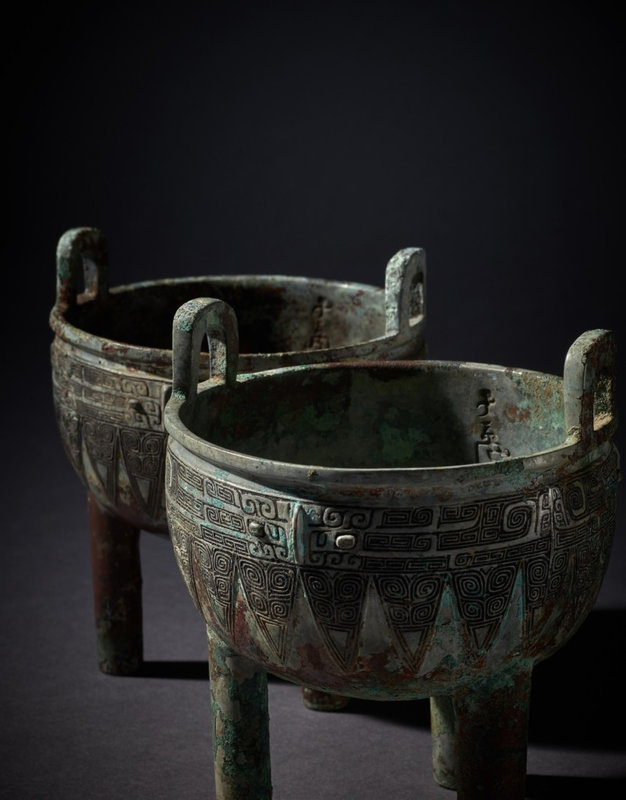


















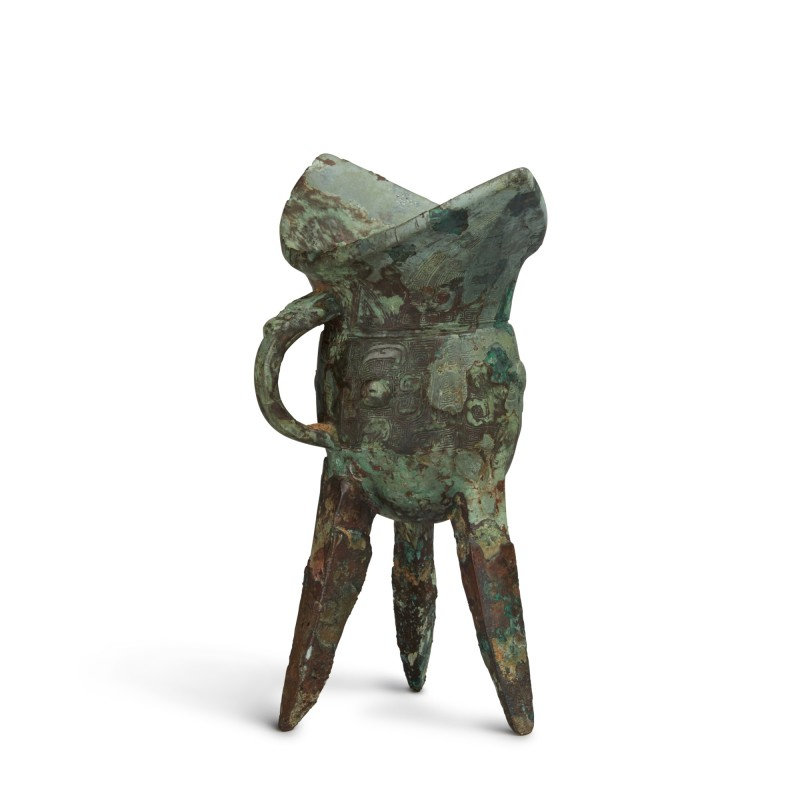
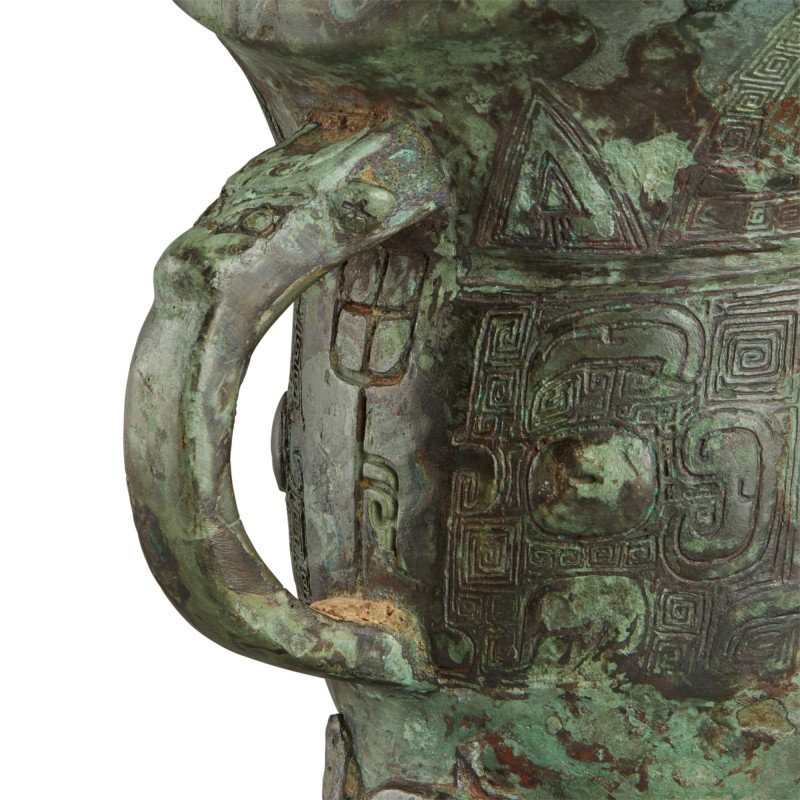
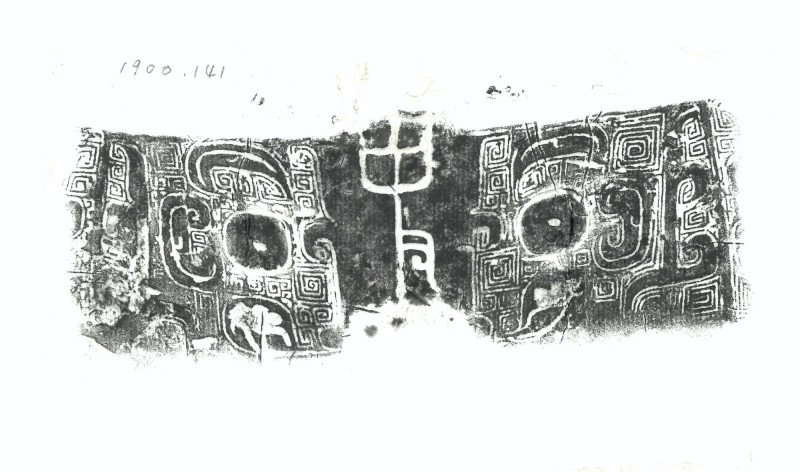

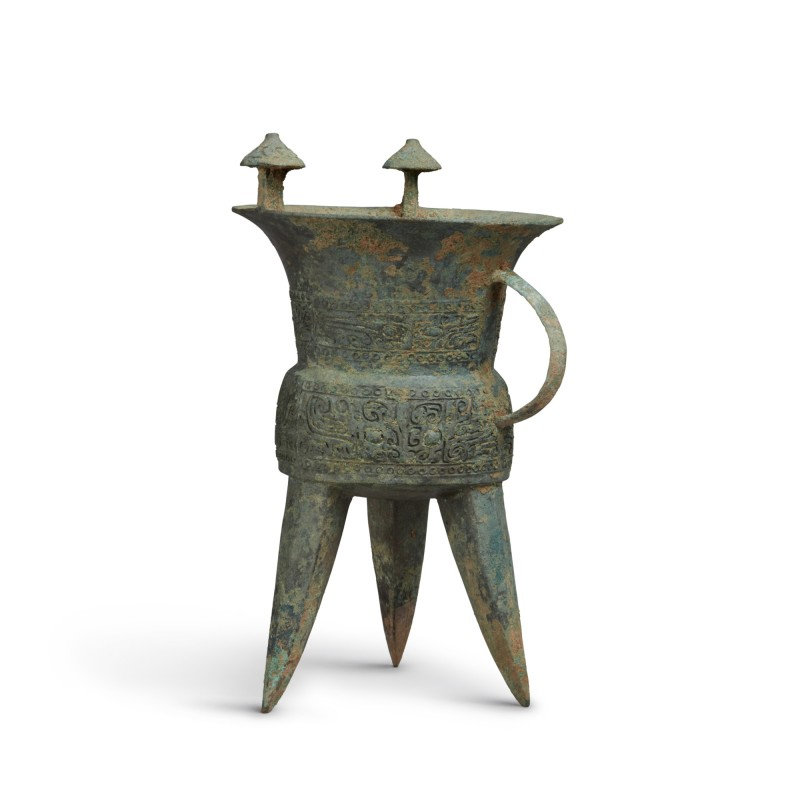


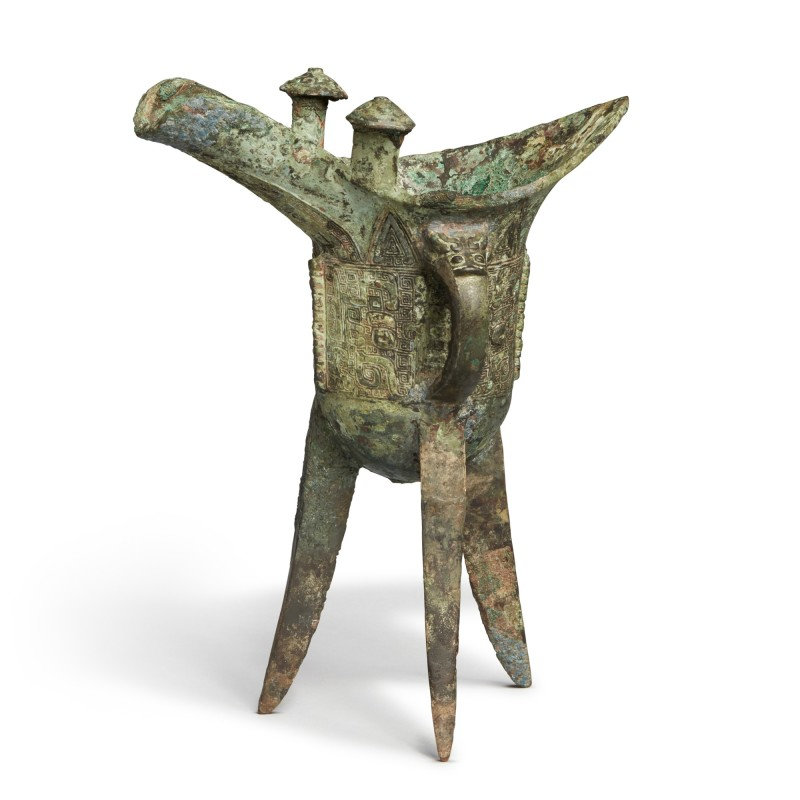
























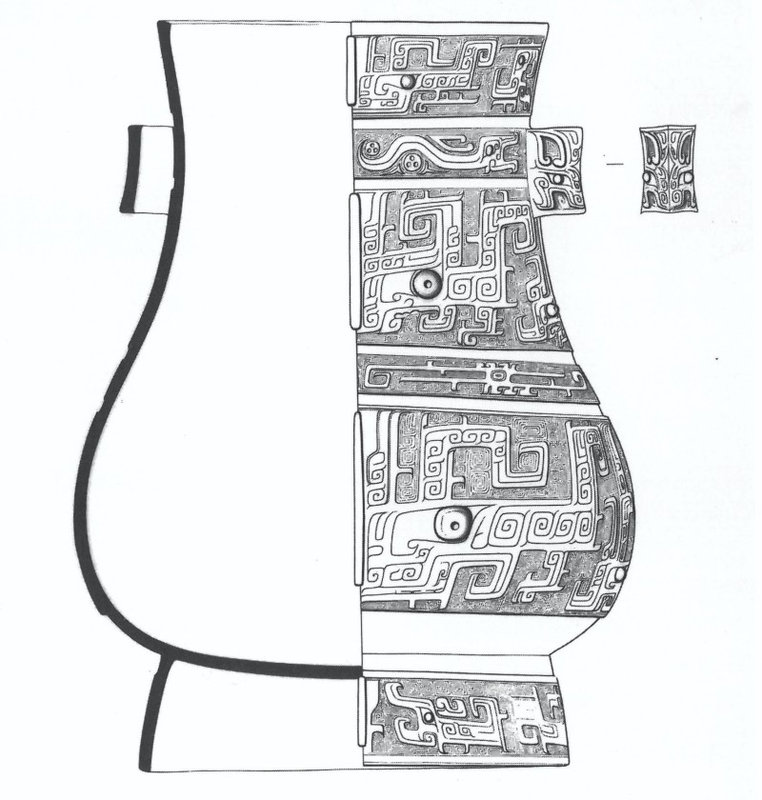


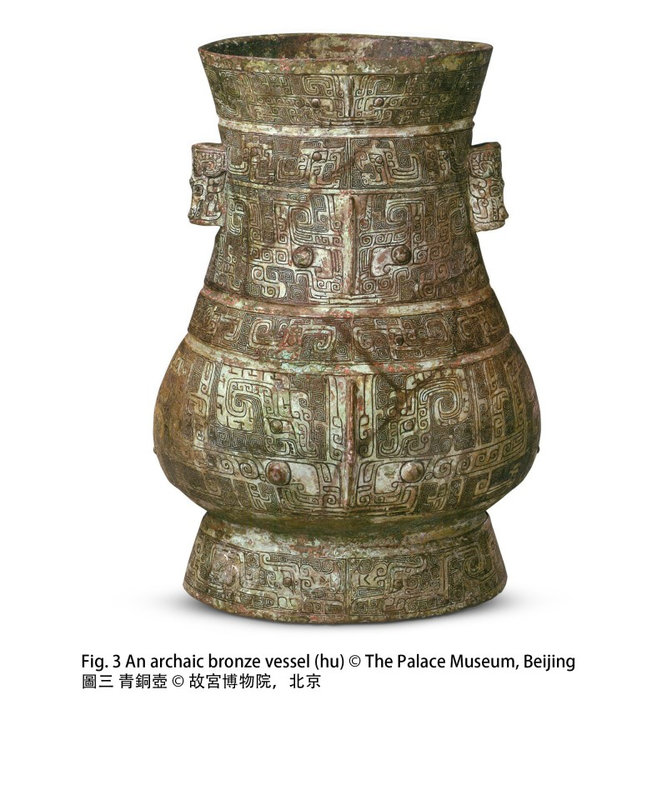
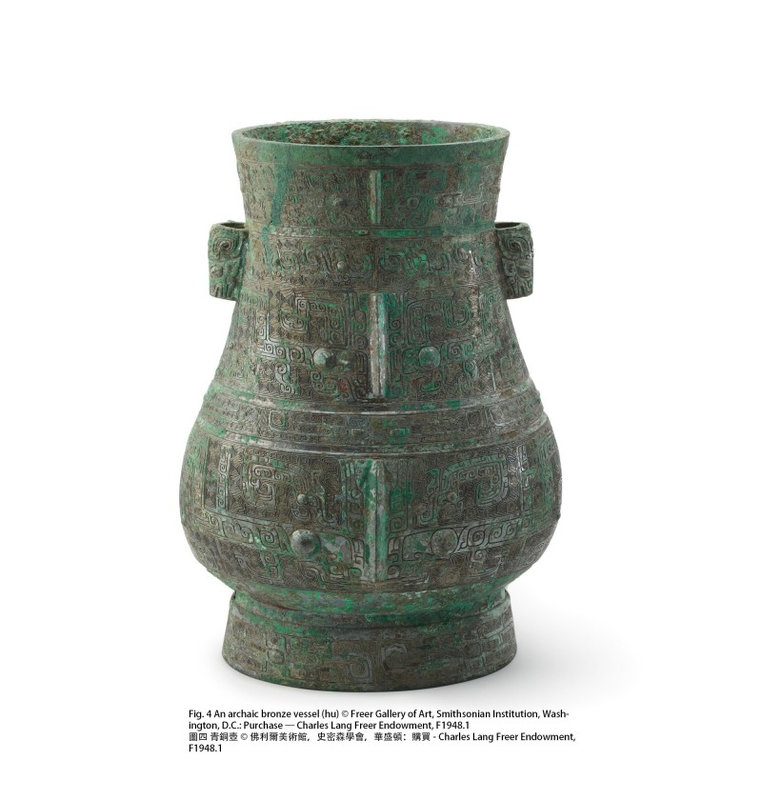

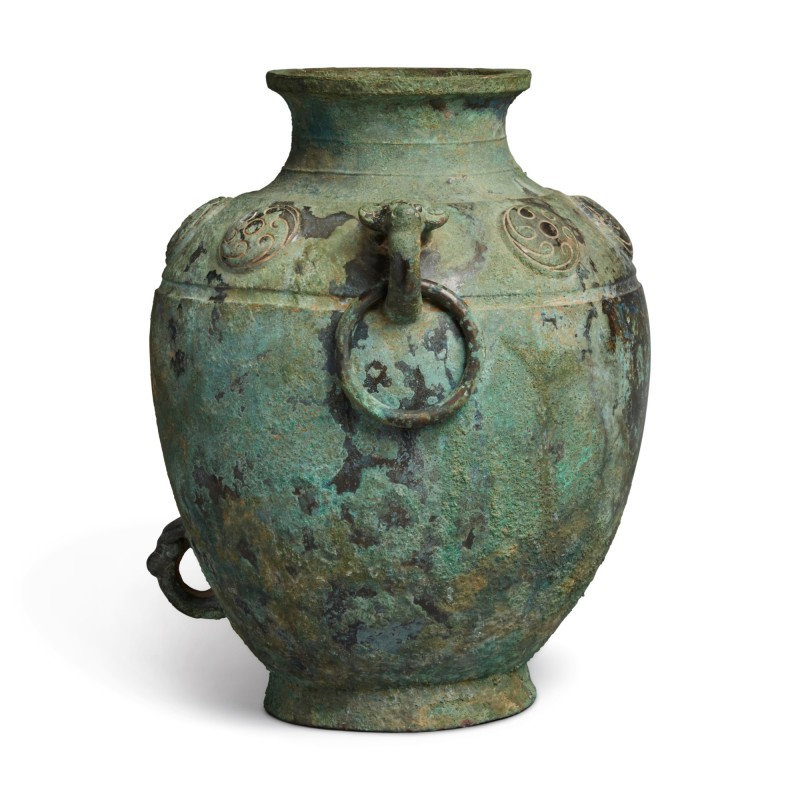
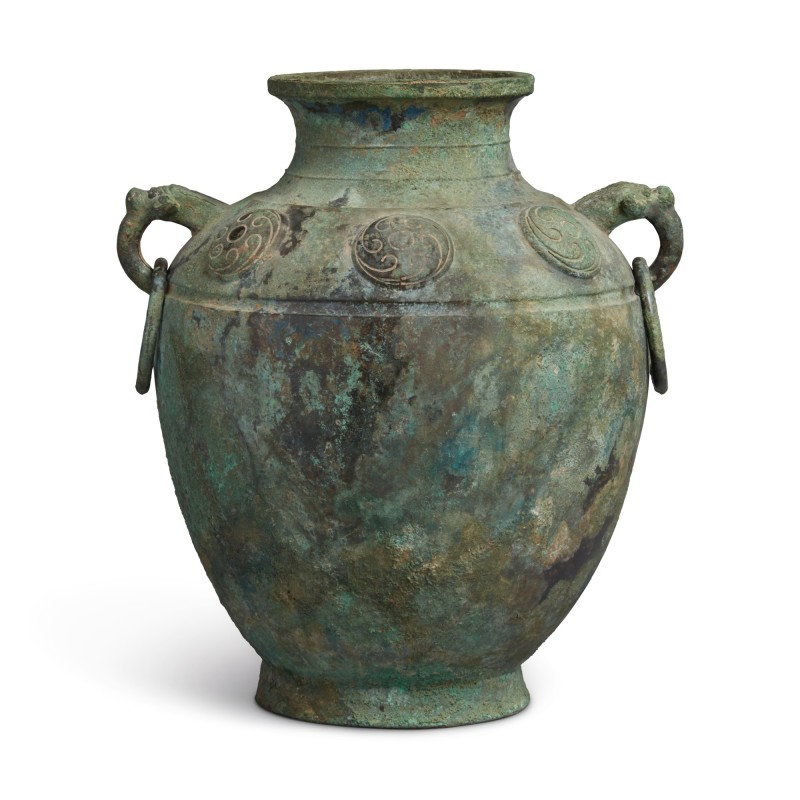






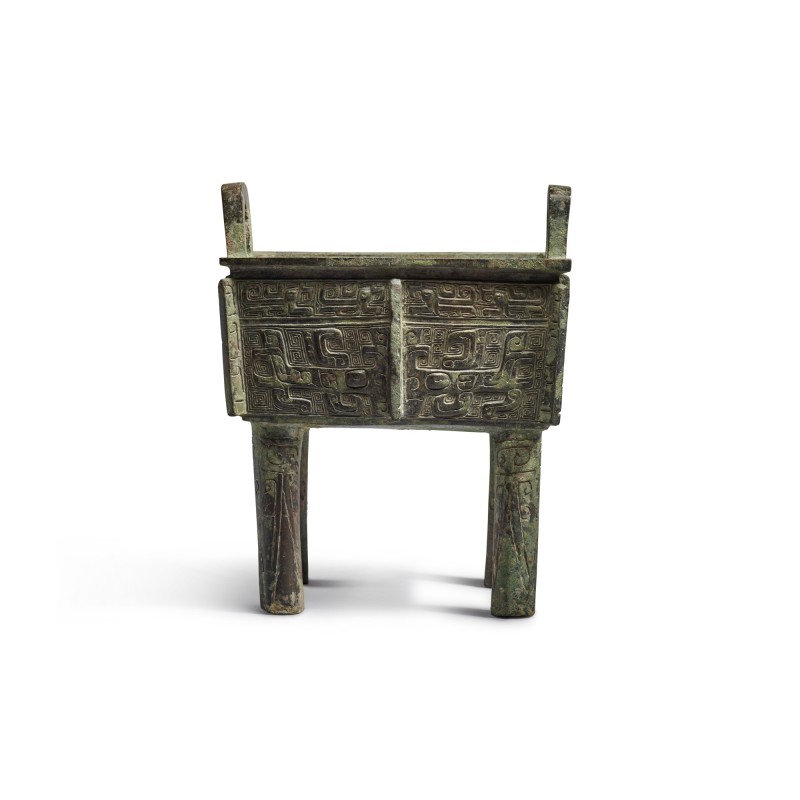






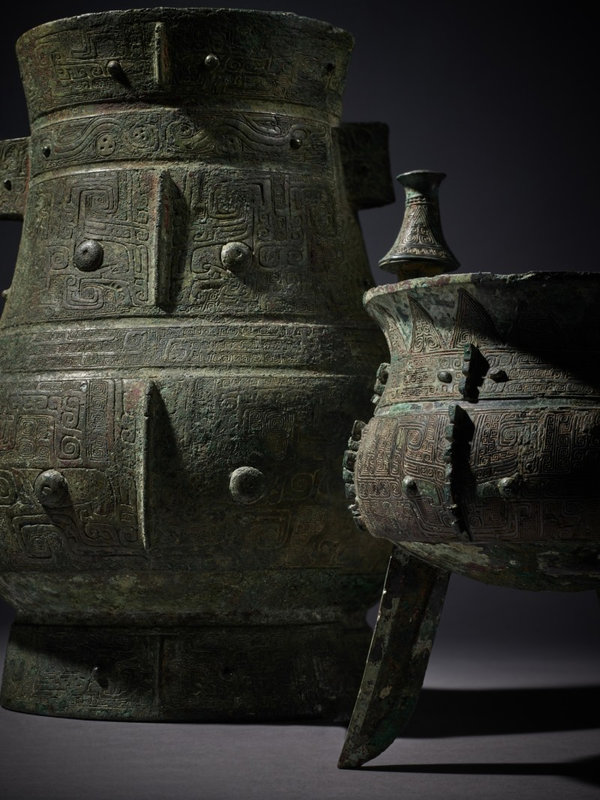

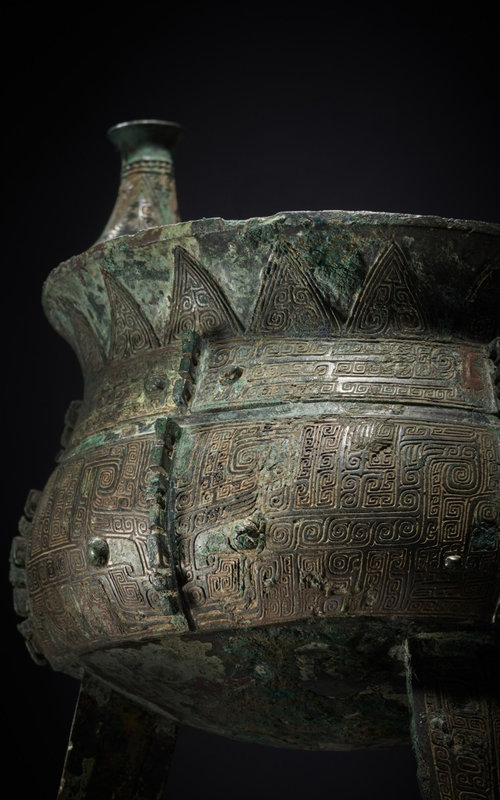
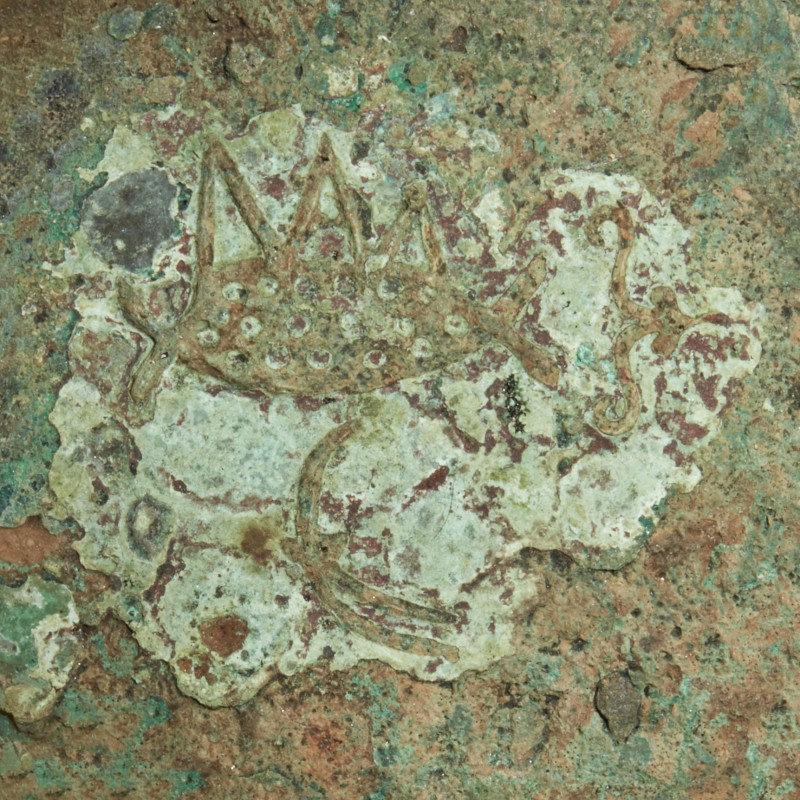




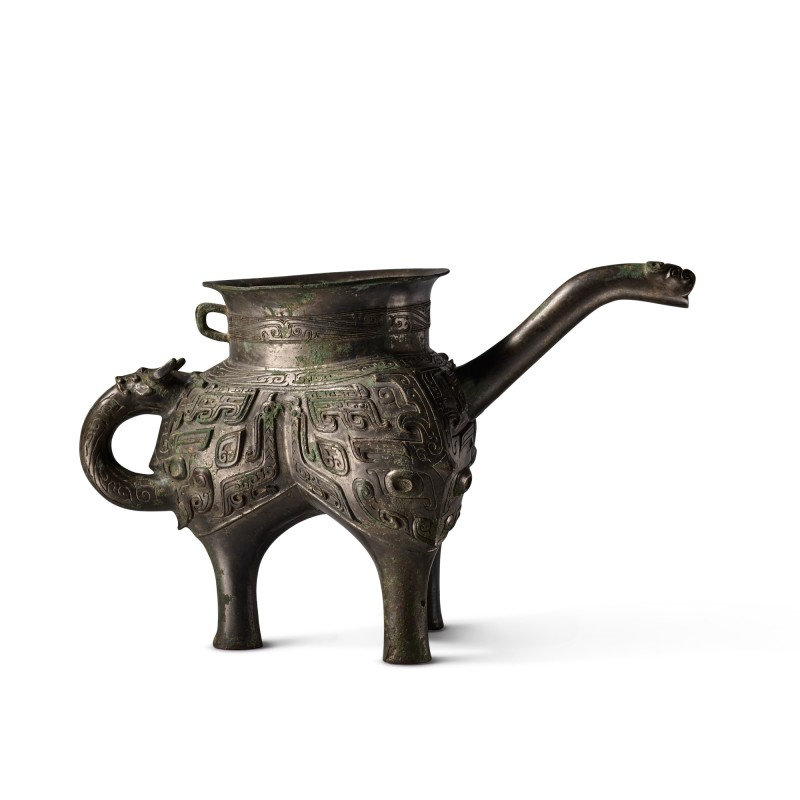


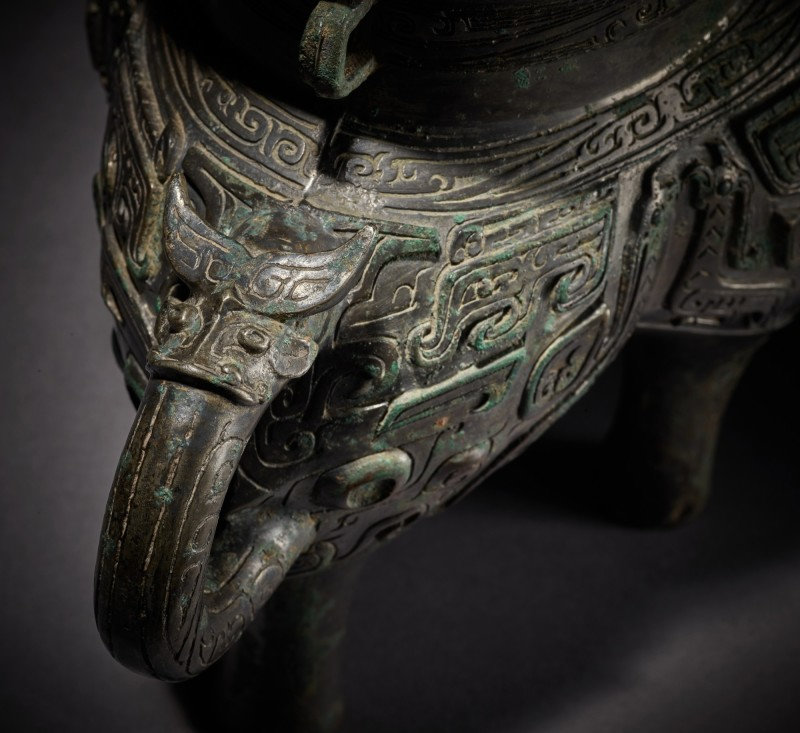






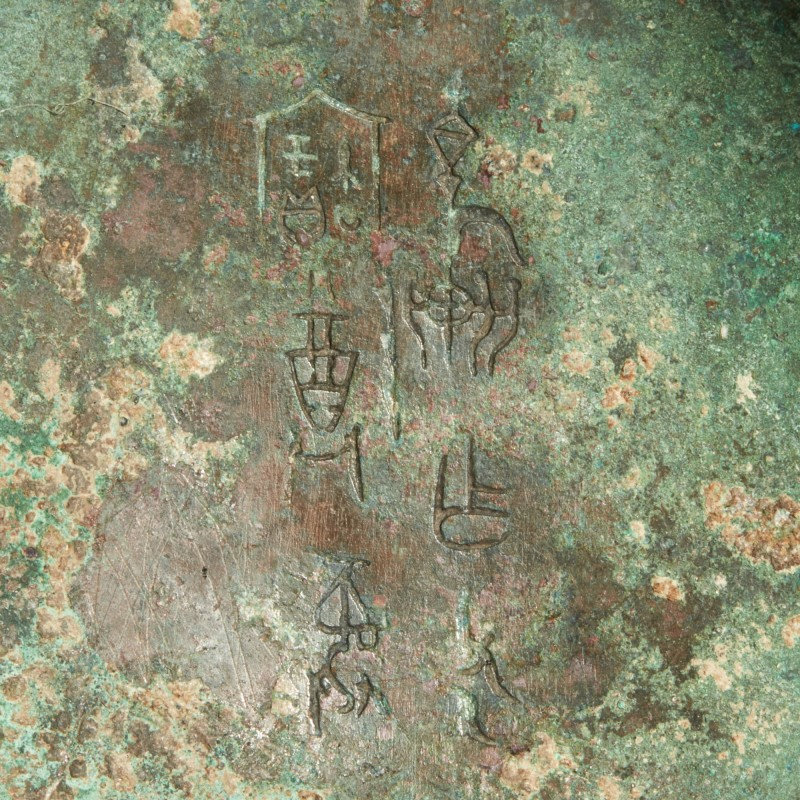


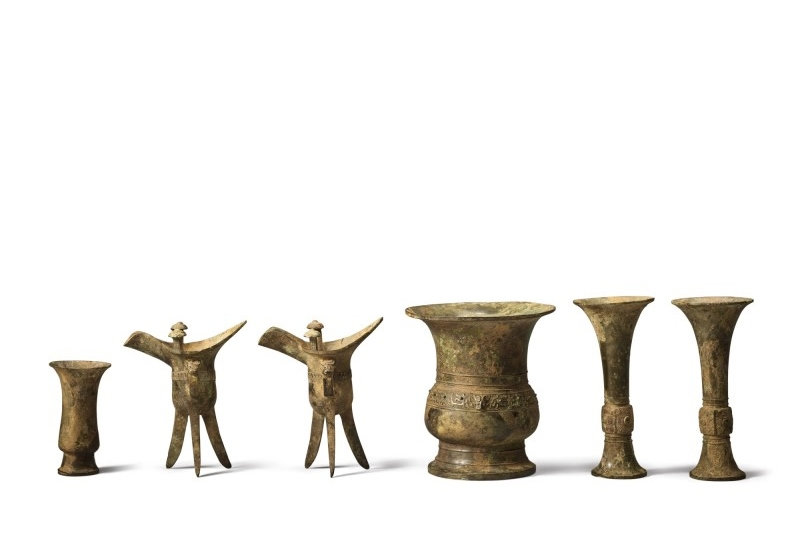

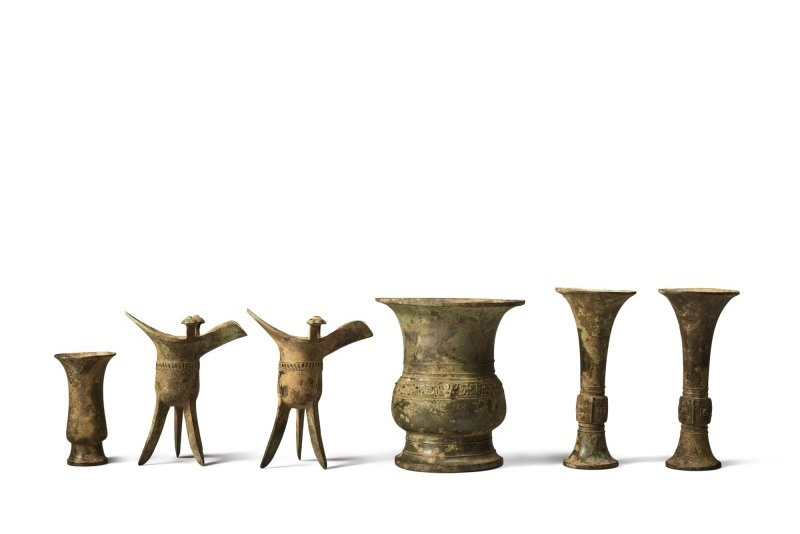
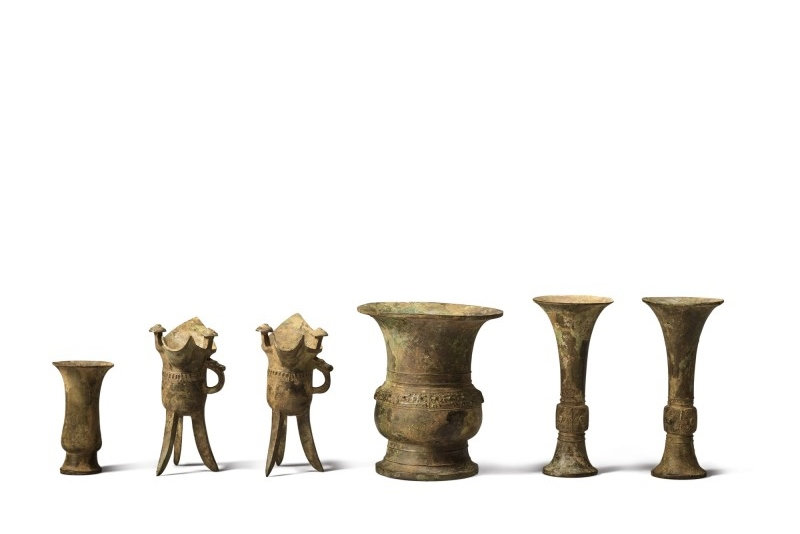










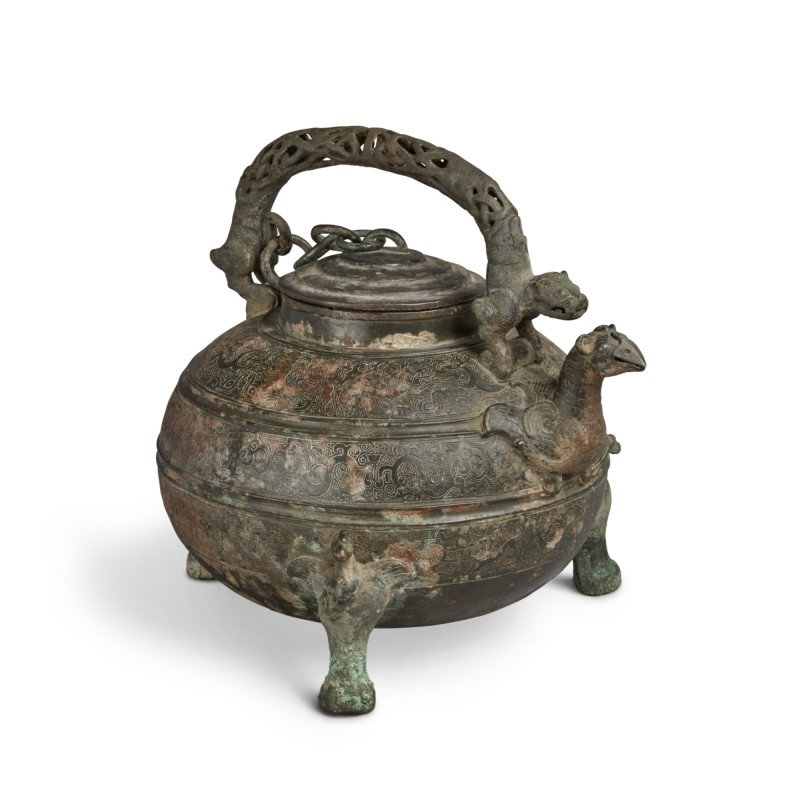


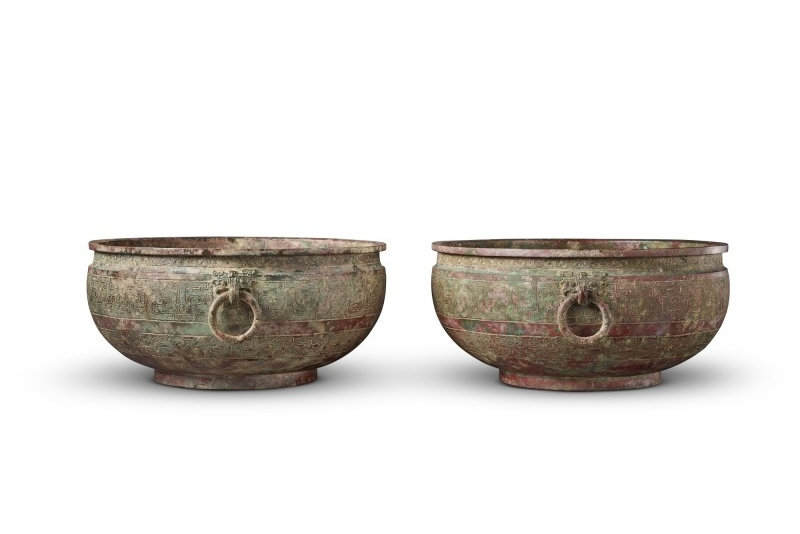
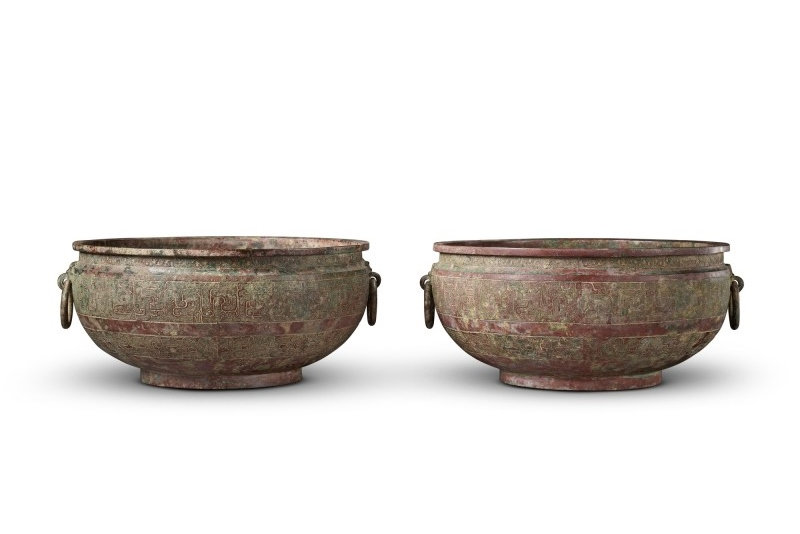

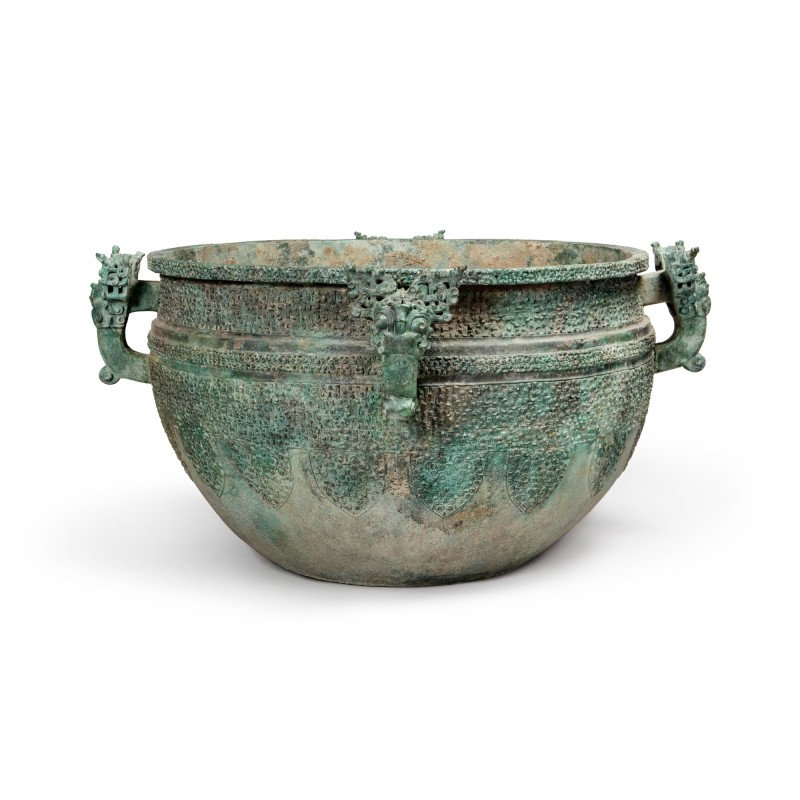
















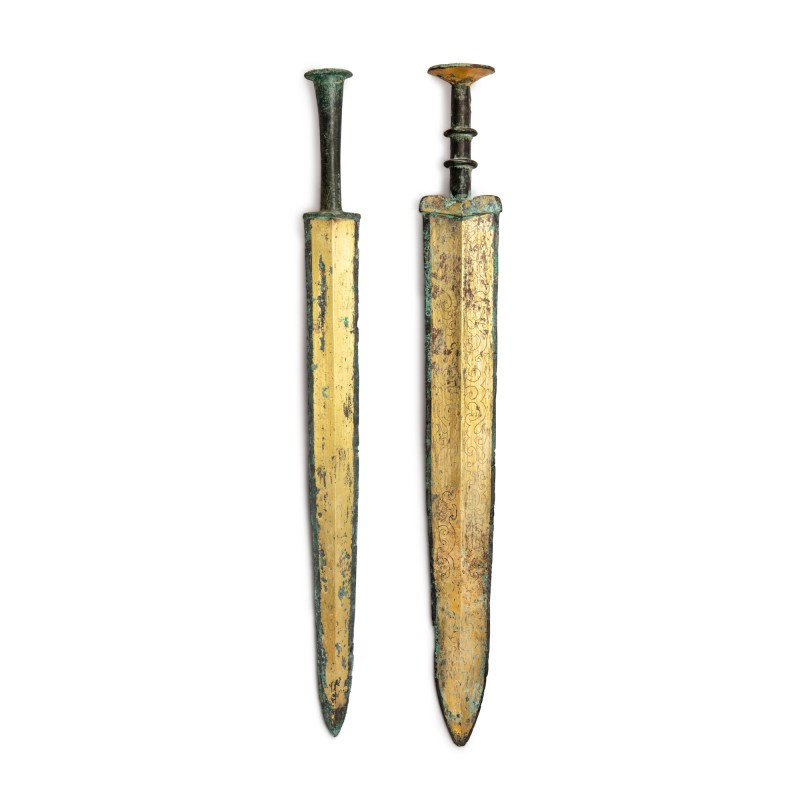
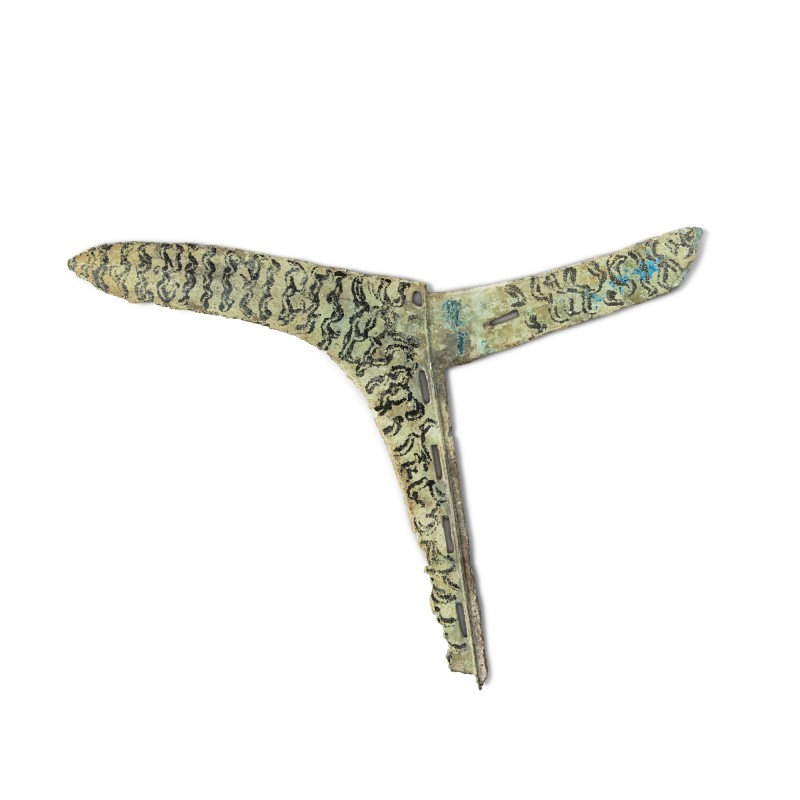

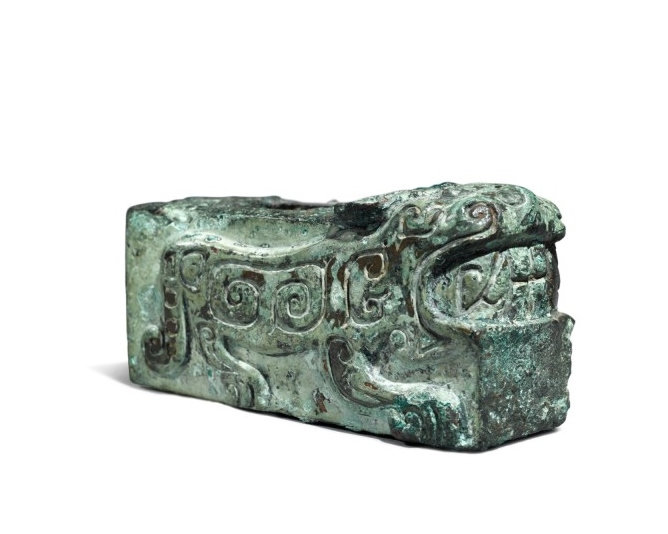





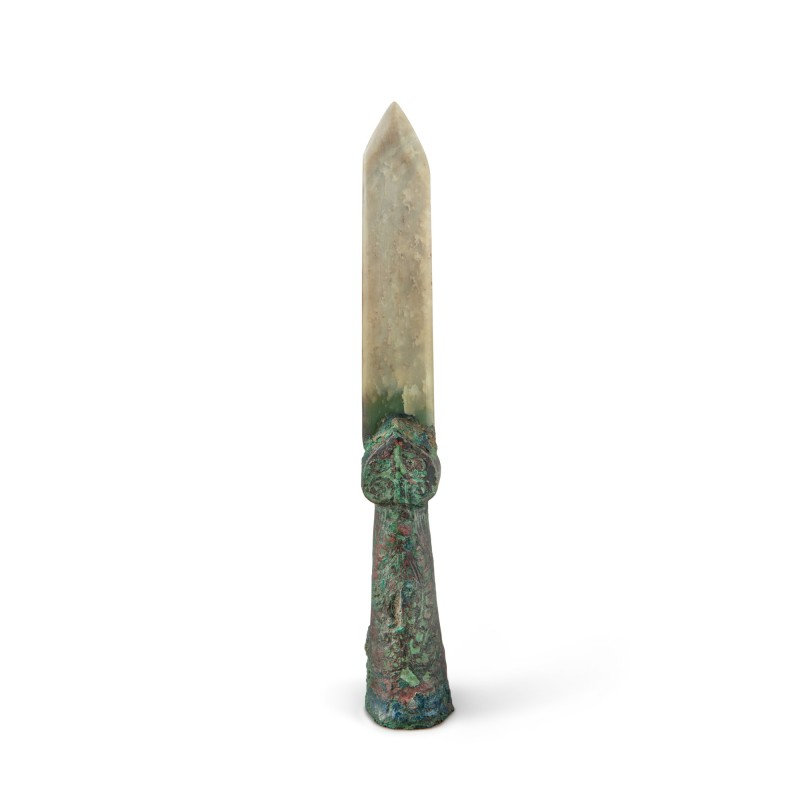


/image%2F1371349%2F20240407%2Fob_35c671_435786660-1647098469393499-37215121468.jpg)
/http%3A%2F%2Fstorage.canalblog.com%2F34%2F15%2F119589%2F129831053_o.jpg)
/http%3A%2F%2Fstorage.canalblog.com%2F04%2F42%2F119589%2F129831017_o.jpg)
/http%3A%2F%2Fstorage.canalblog.com%2F09%2F92%2F119589%2F129819533_o.jpg)